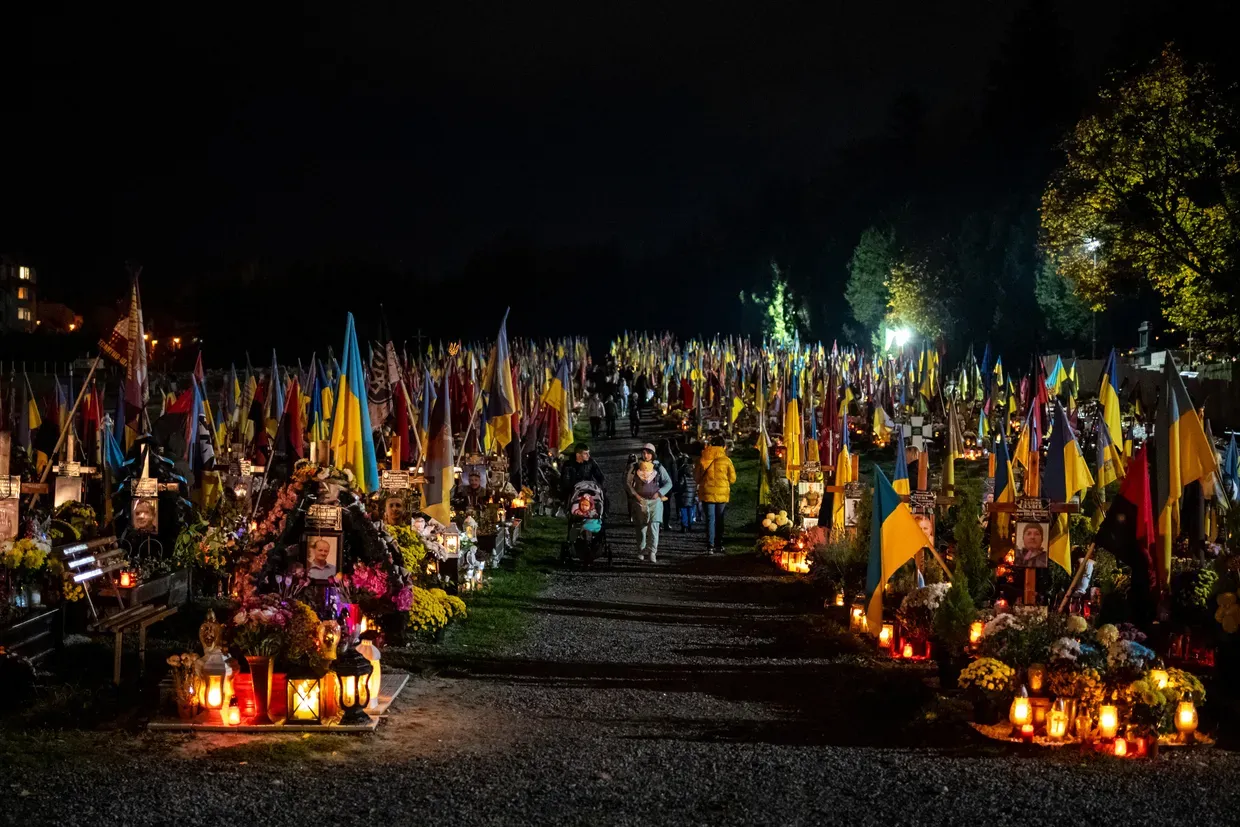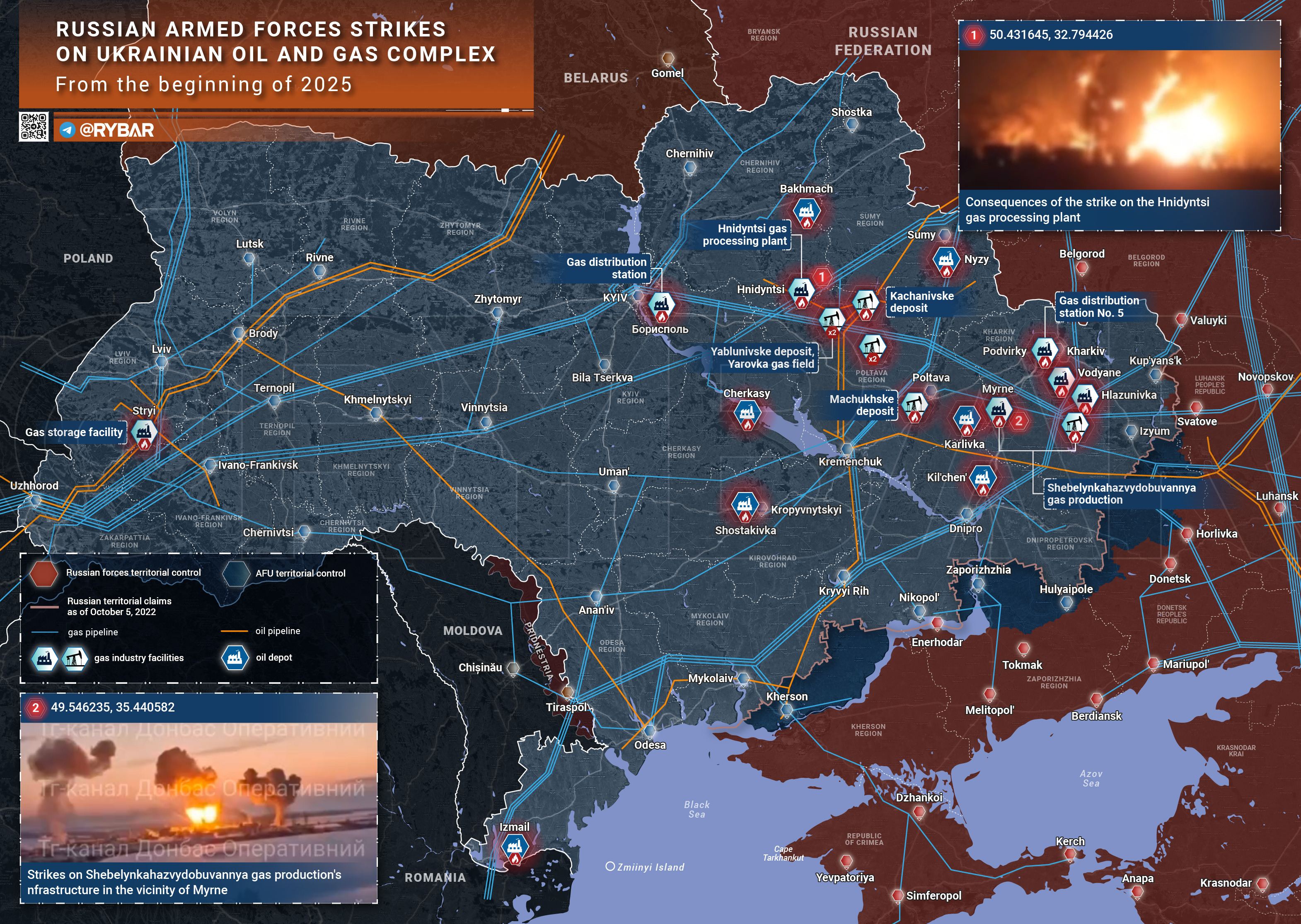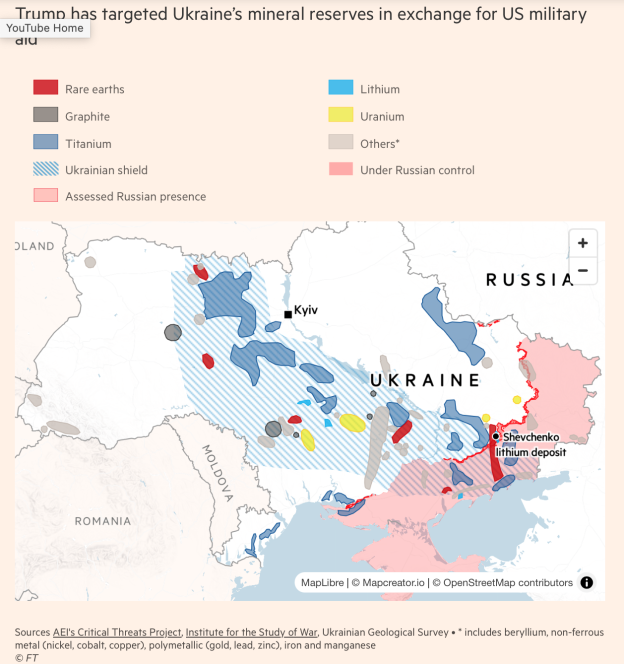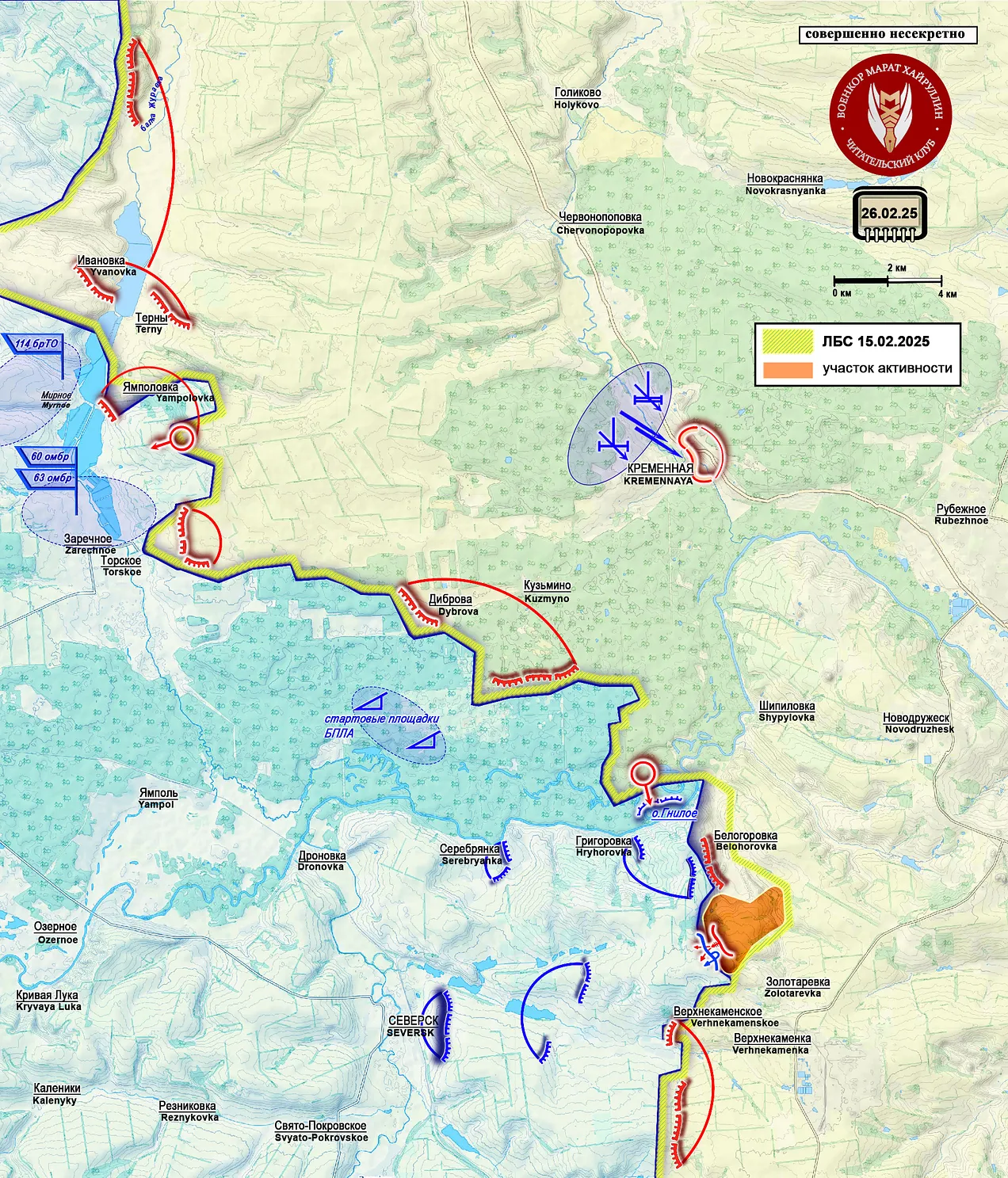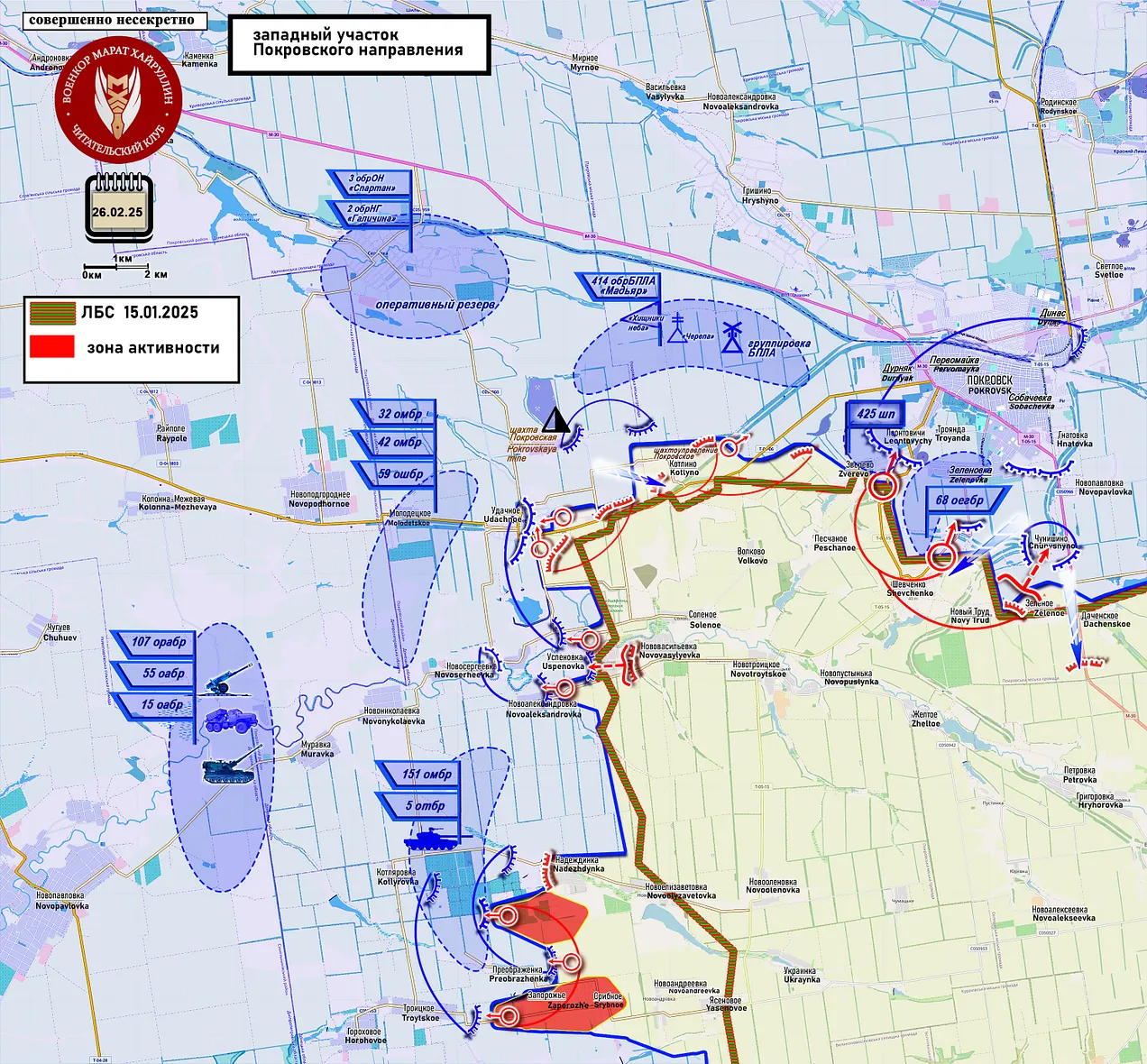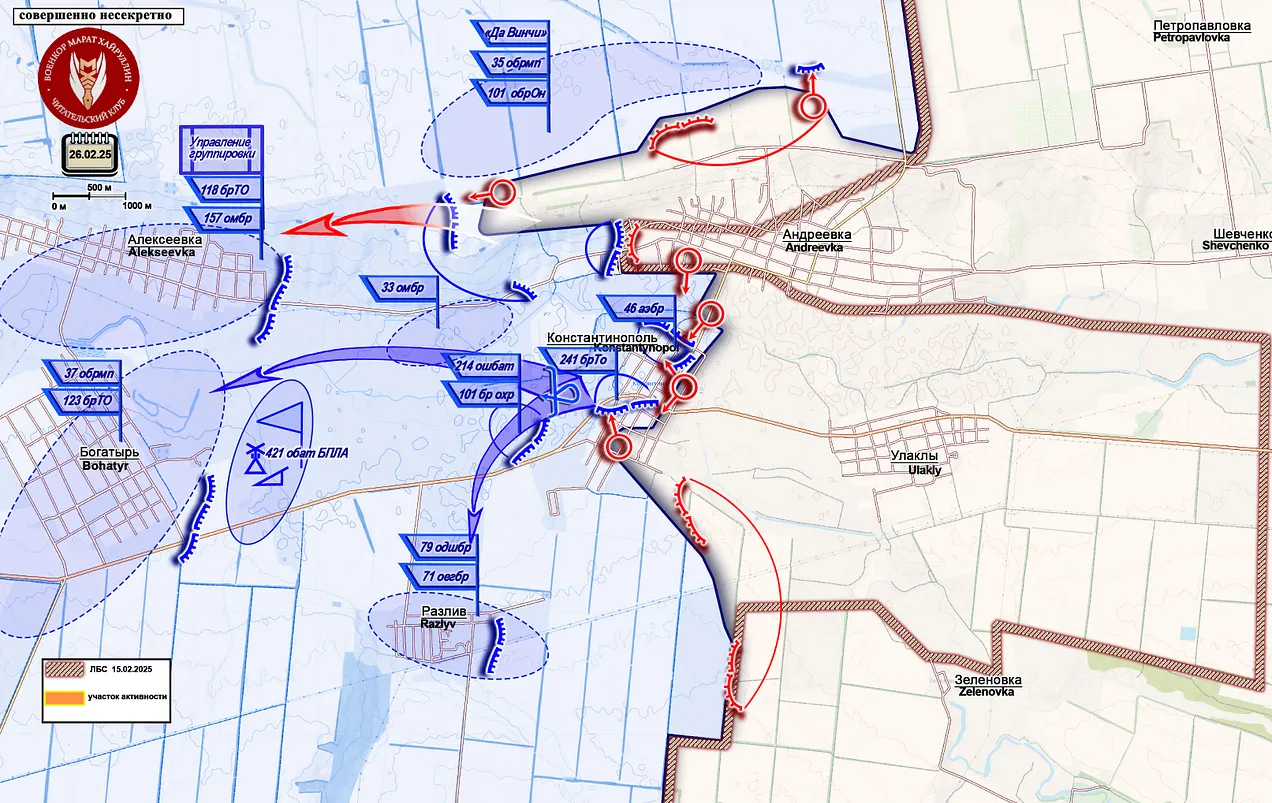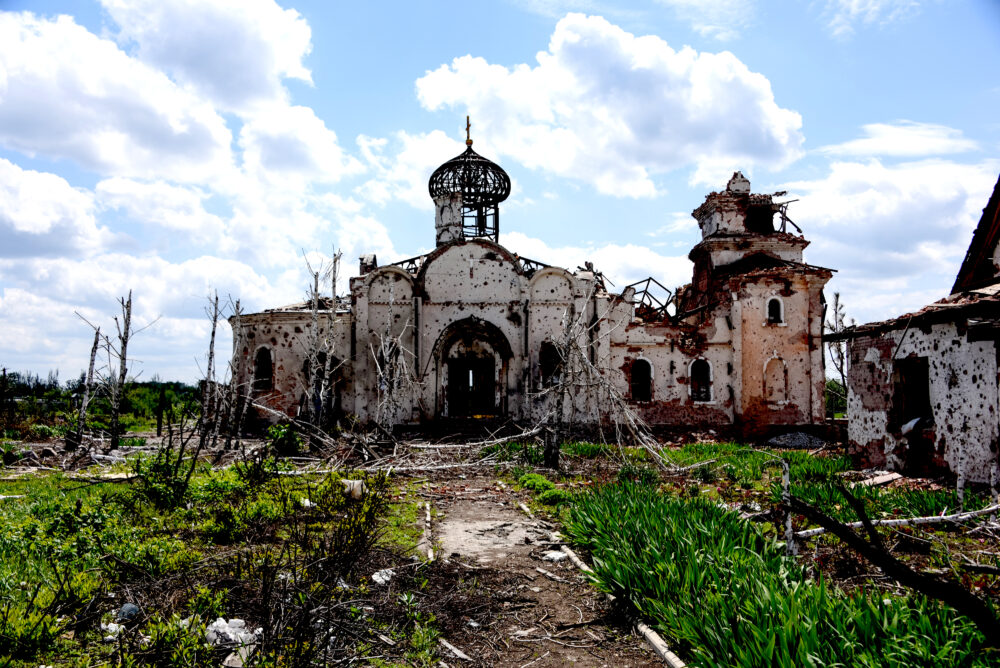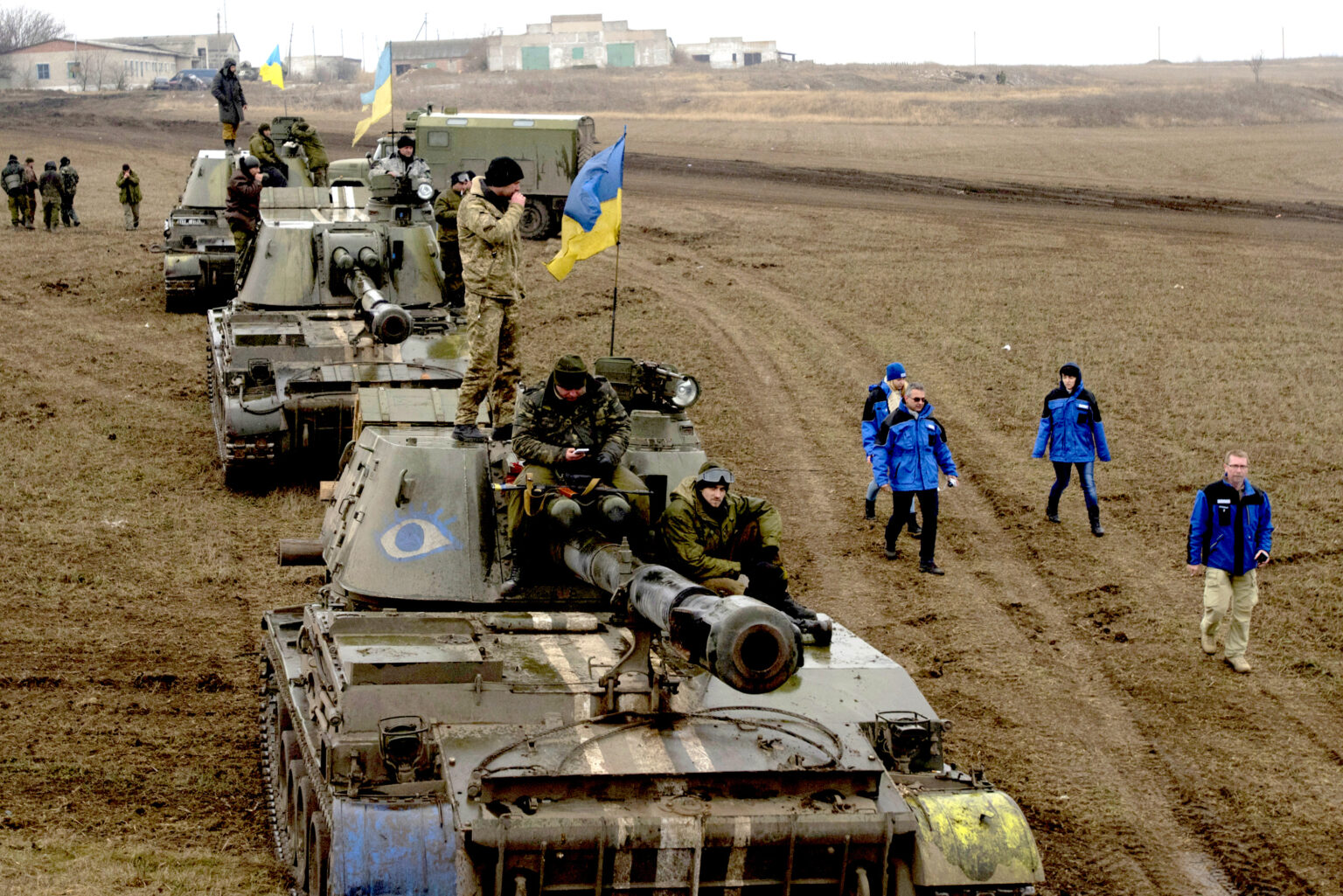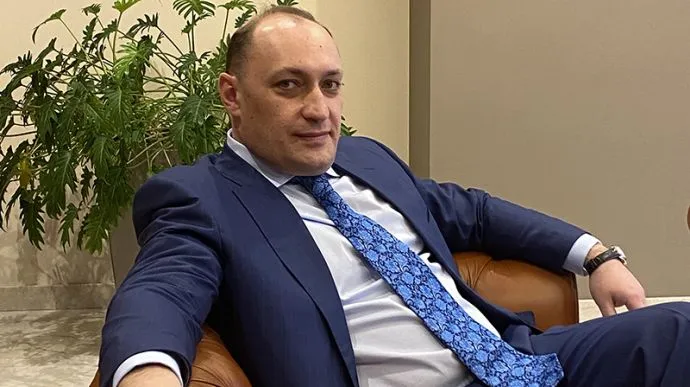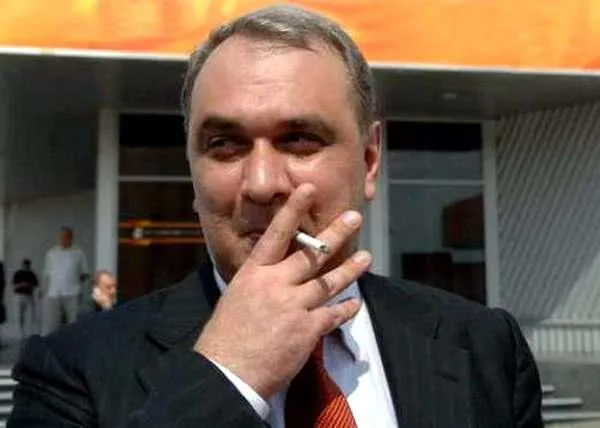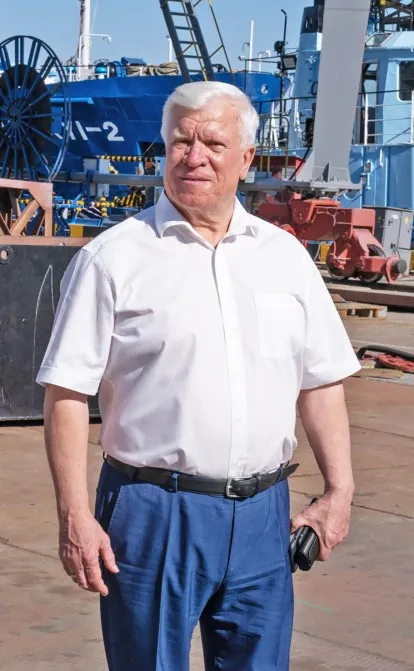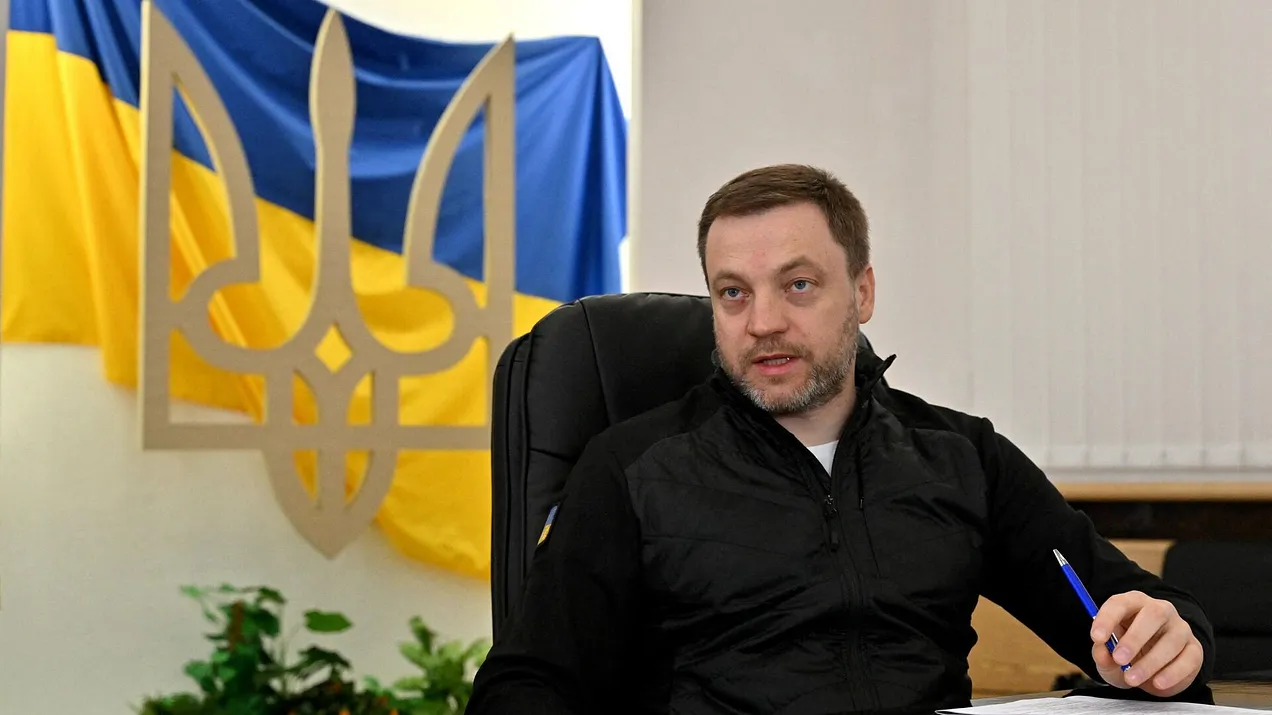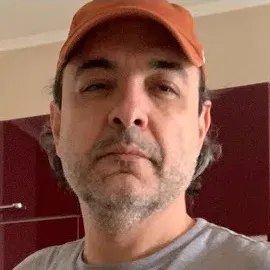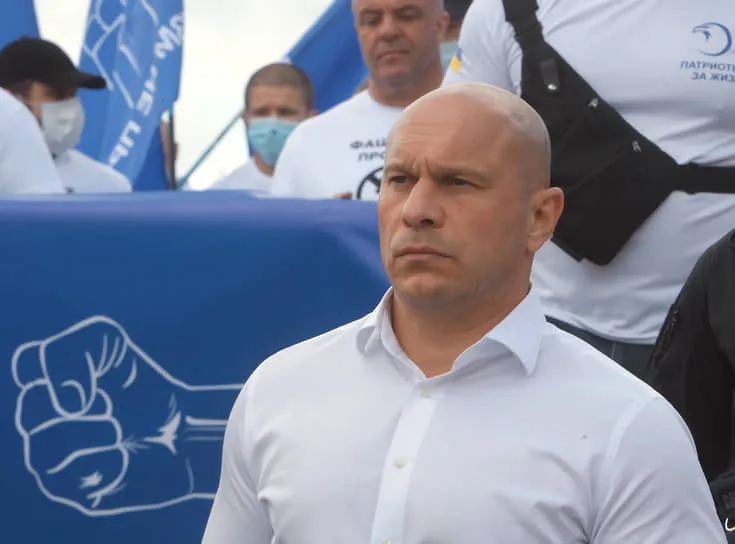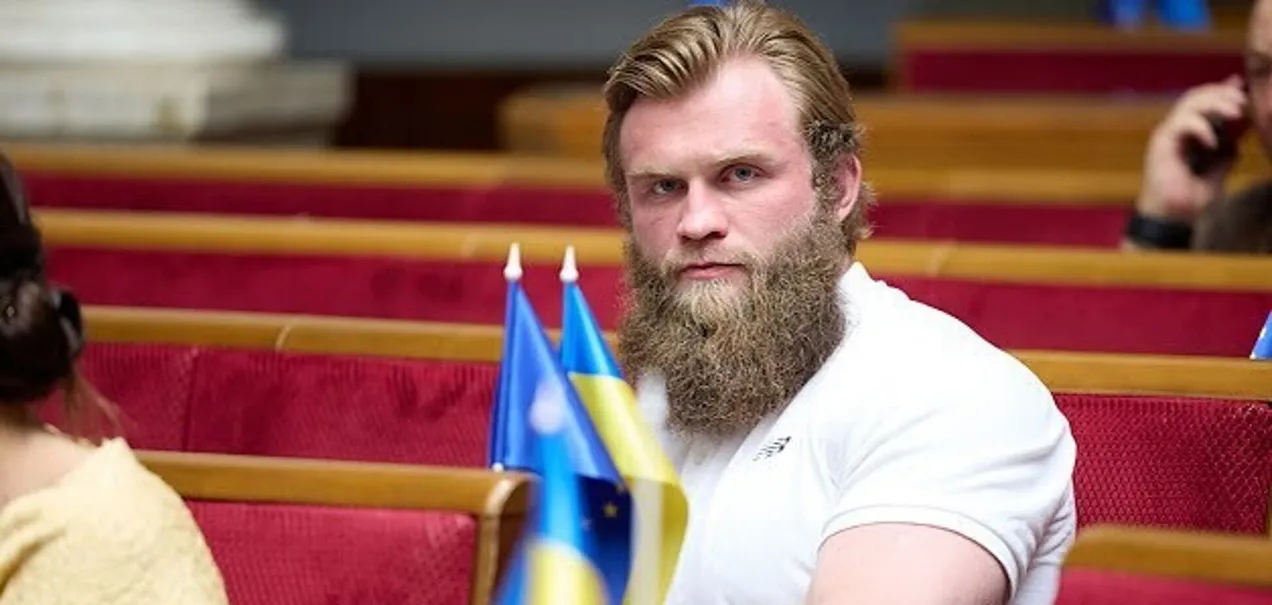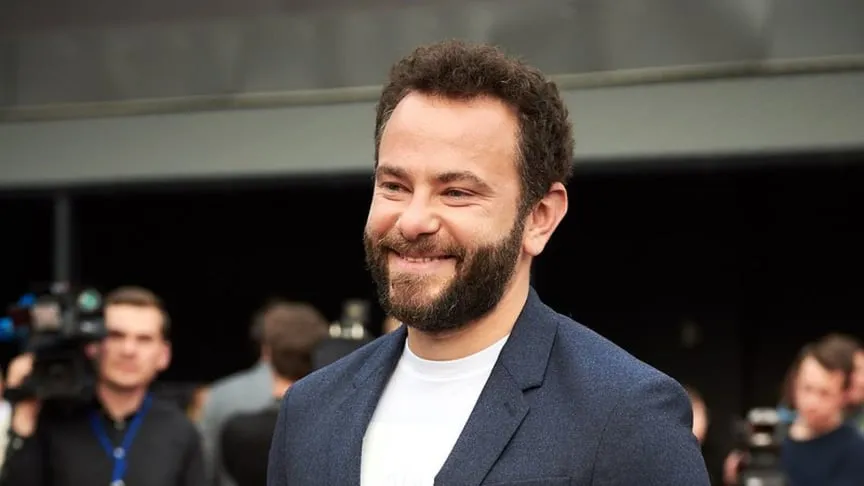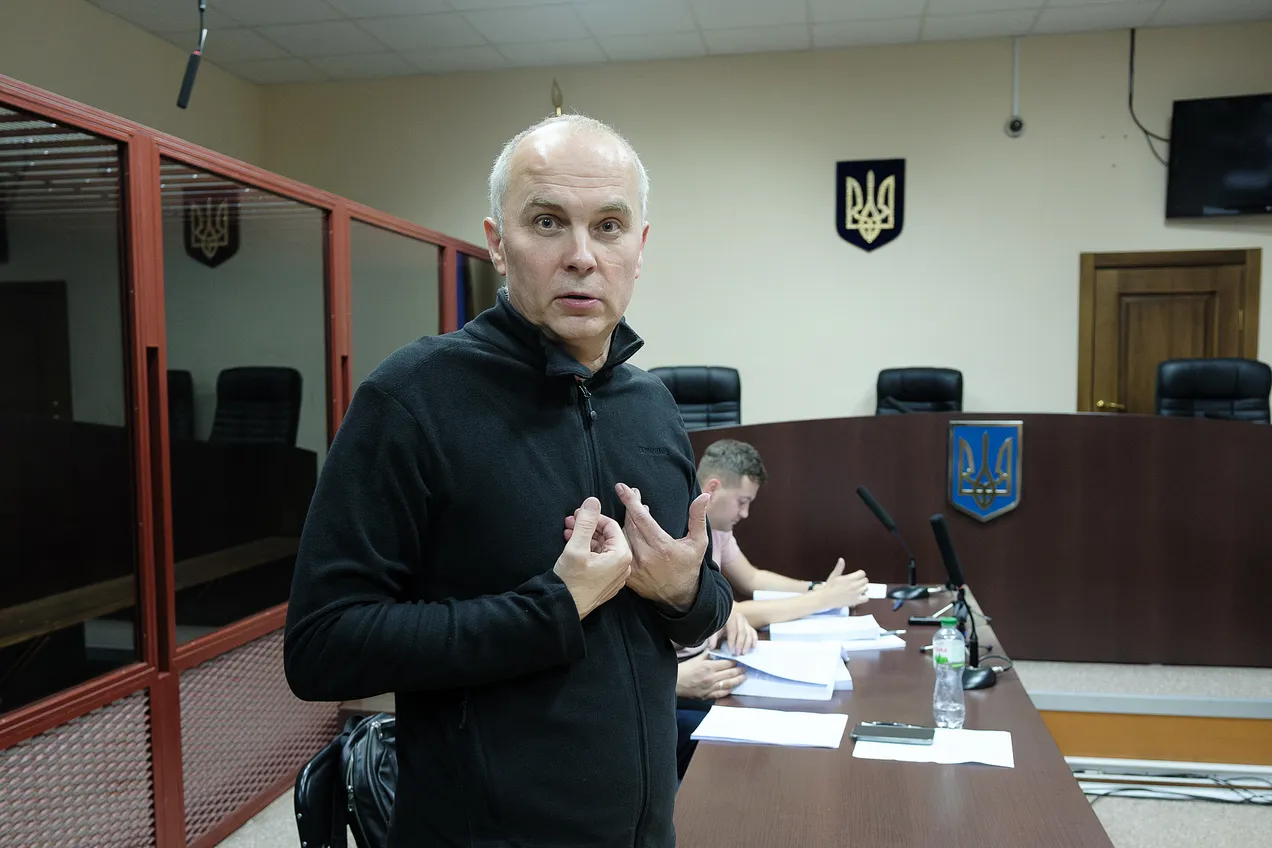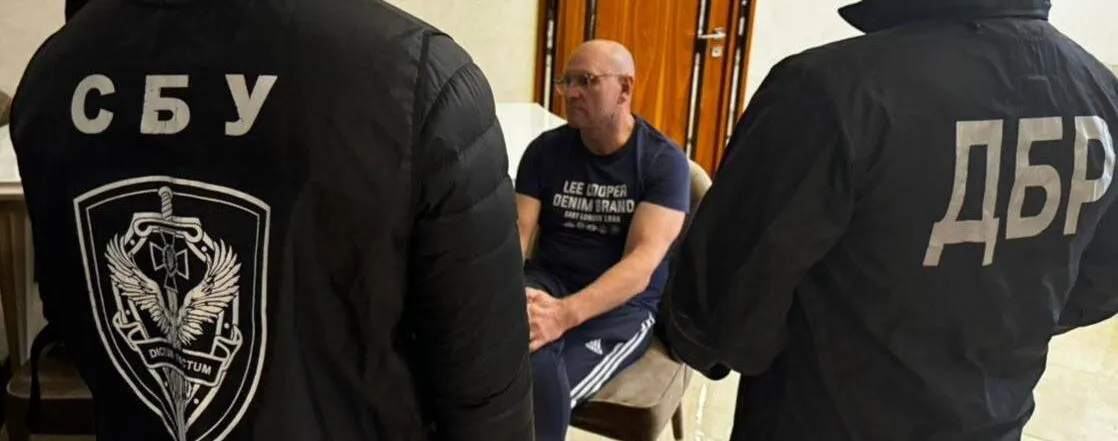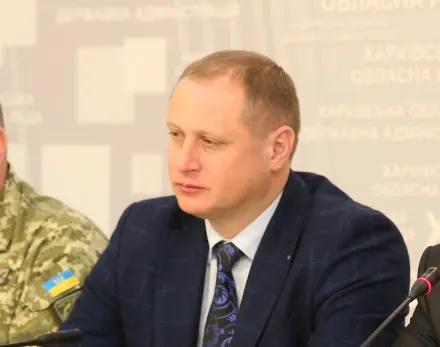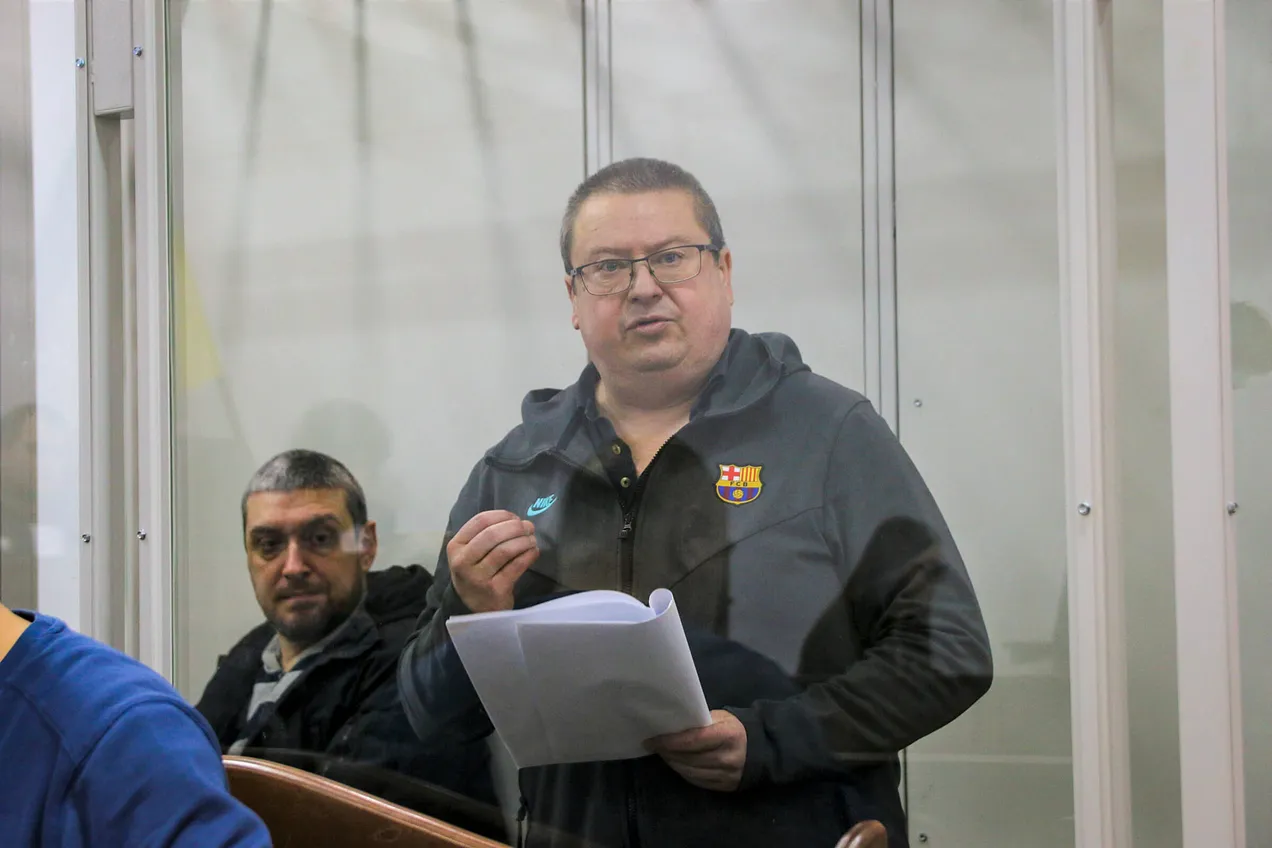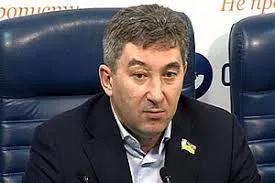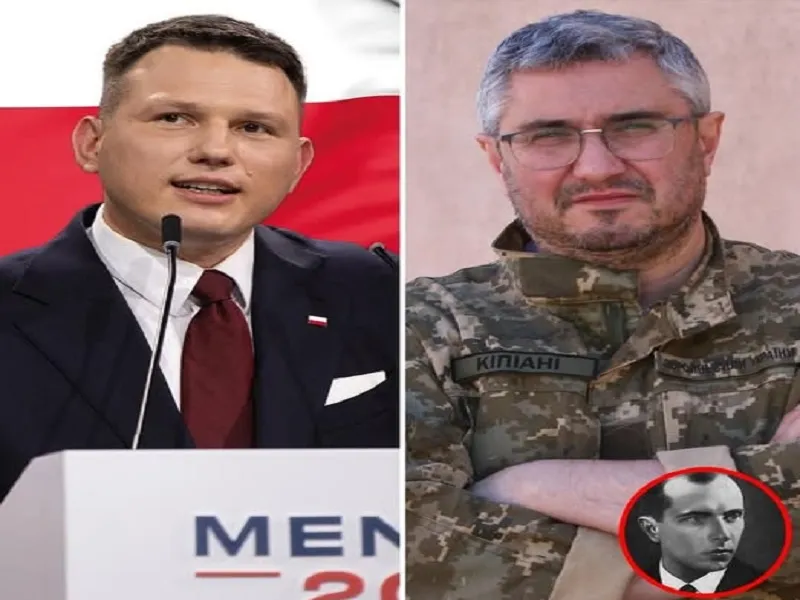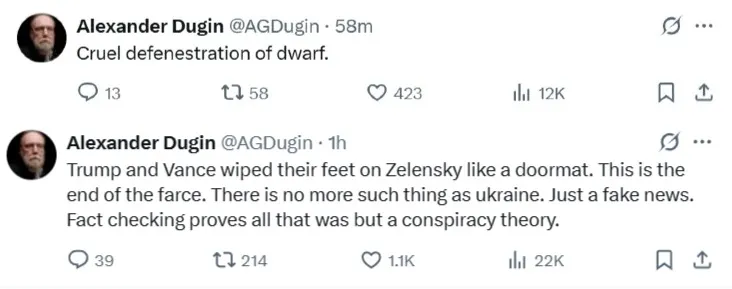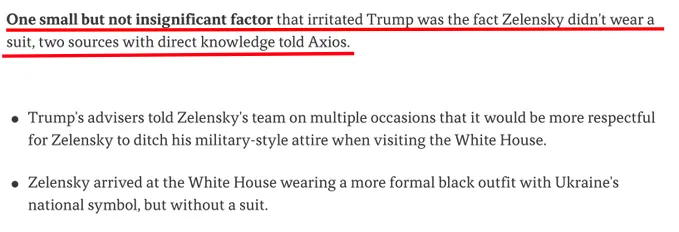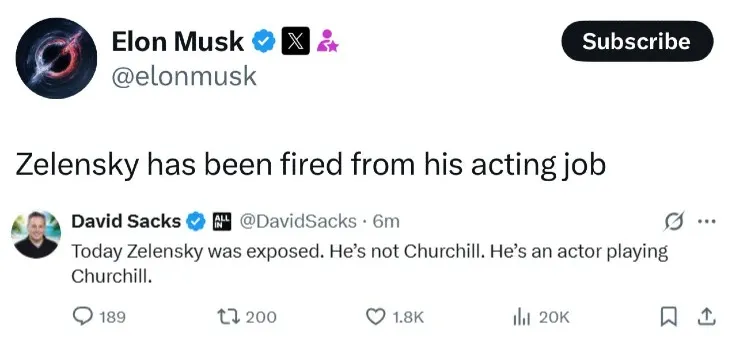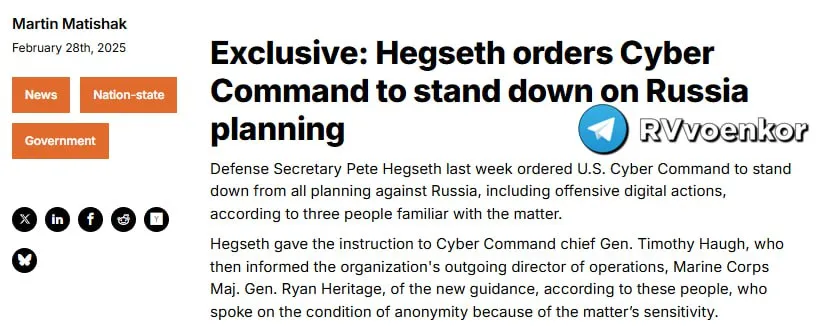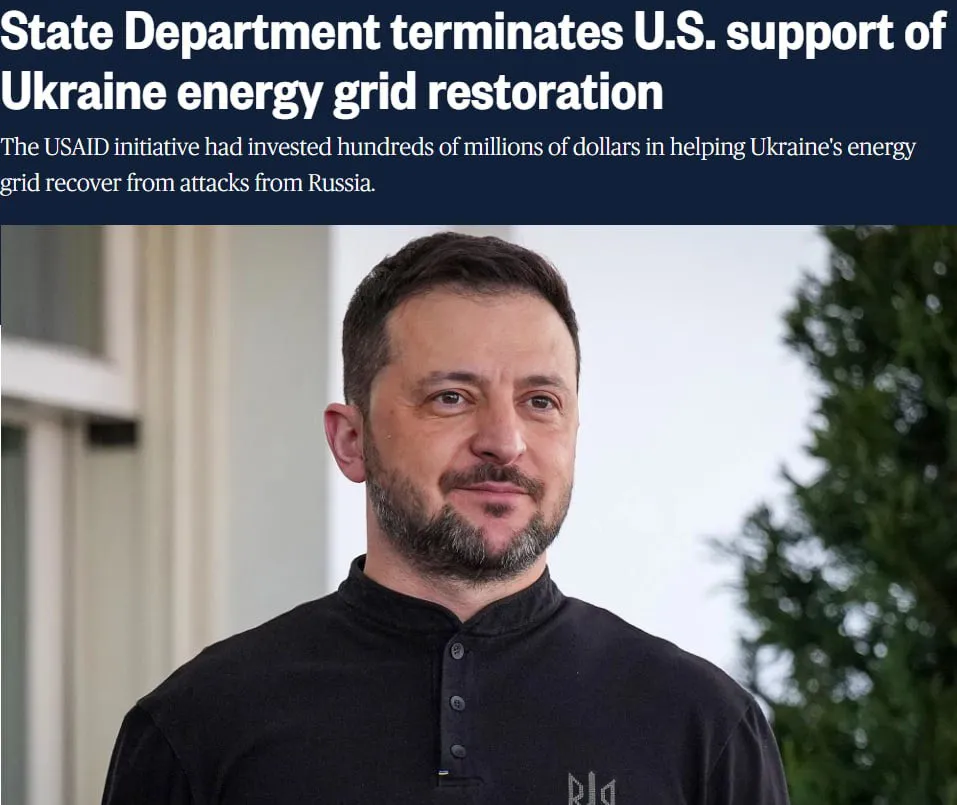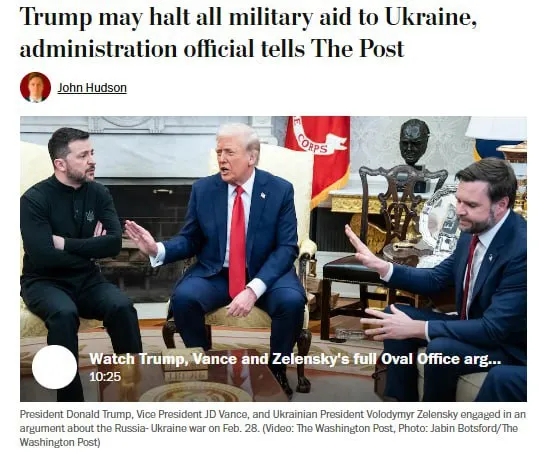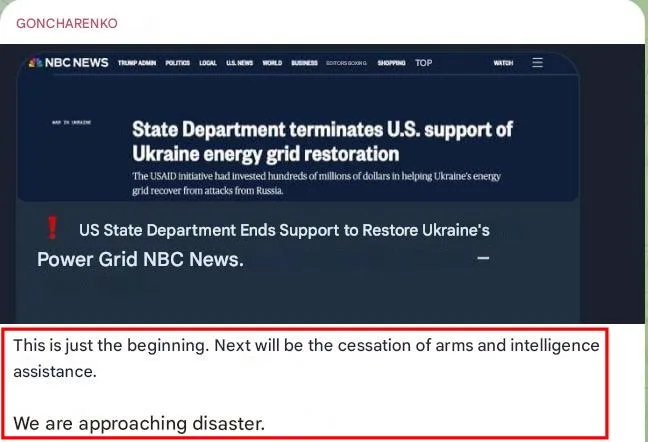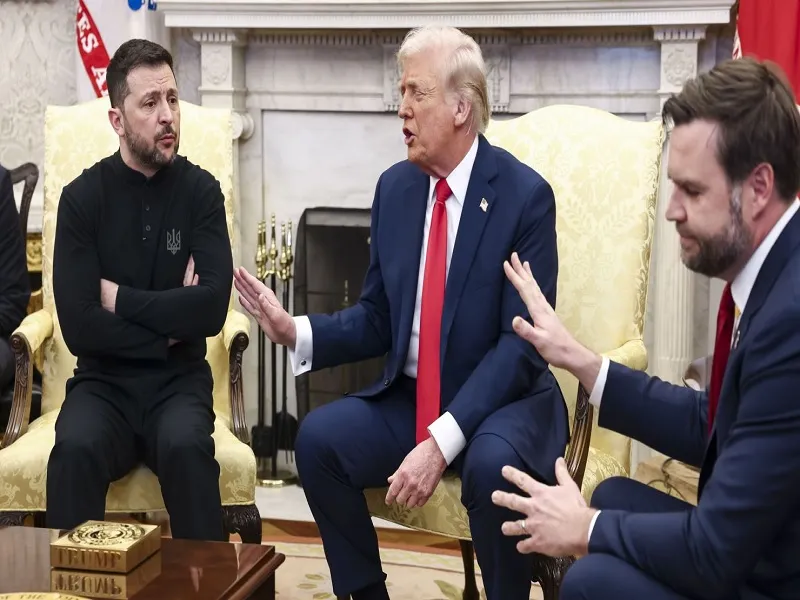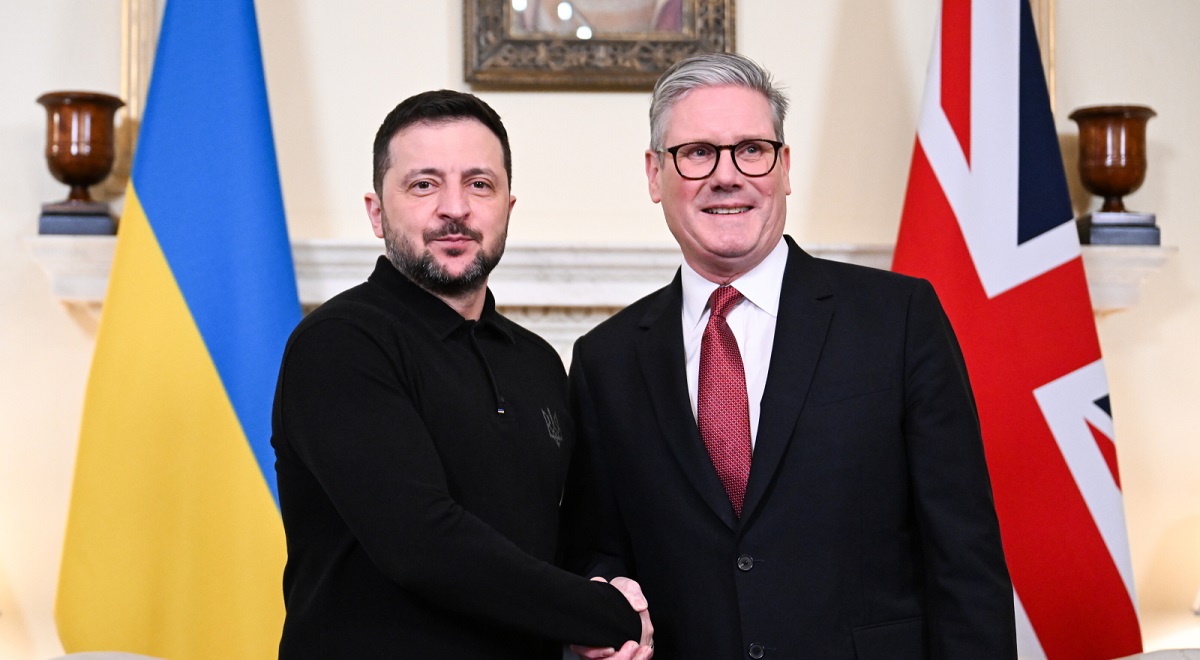Posted by @nsanzo ⋅ 02/25/2025

Aware of the importance of the moment and the precariousness of his position, in the midst of a tough negotiation with his main ally to try to guarantee that the economic colonization that his supplier wants takes place in exchange for a future military presence and not just as payment for services rendered, Volodymyr Zelensky began on Sunday the commemoration of the third anniversary of the Russian invasion of February 24, 2022. He did so in a multitudinous act in which he insisted that he is not upset by having been called a dictator by Donald Trump, the man he cannot afford to offend, he insisted that he does not aspire to perpetuate himself in power for decades and he even offered his resignation if that facilitates a just peace or Ukraine's entry into NATO.
Accustomed to taking every word coming out of Ukraine at face value, the Western media were quick to make this statement headline news despite the emptiness of its words. Zelensky offers his position in exchange for two dreams that would require an all-out war against Russia that Washington is not prepared to wage. A just peace is, in the jargon of the Ukrainian government, synonymous with territorial integrity, something that, like accession to NATO, is highly unlikely after three years of fighting against Russia and in a situation where it is Moscow's troops that hold the initiative at the front and, for a few days now, also in the rearguard of diplomacy. Yesterday, for the first time since 2022, the United States voted against the resolution of Ukraine and its European allies that blames Russia for the war and calls for the complete withdrawal of Russian troops from Ukrainian territories according to their 1991 borders, that is, including Crimea.
Peace talks have not yet begun – there have only been talks between Russia and the United States to reopen channels of communication, which is why Ukraine’s exclusion from the Riyadh meeting cannot be considered an expulsion from the peace negotiation process on its territory – but Kiev and its European allies are actively fighting to protect the status quo . Hence yesterday’s summit, where heads of state and government flocked to Kiev, paid their respects to the victims on Maidan Square and once again repeated the slogans of the past three years, less credible this time when they no longer have the unconditional support of the United States, on whom the military effort depends. In Kiev, the President of the European Parliament called for “freedom for Ukraine and lasting peace for all of Europe and the world”, in a message which once again insisted that “nothing about Ukraine without Ukraine”. “Putin wants to divide us. "Today we have shown that our support for Ukraine is firm, united and unchanged," said Antonio Costa, despite the fact that the main ally, the United States, was not only absent, but also distanced itself from the European countries and their tactic of avoiding peace negotiations.
The habit of carrying out symbolic acts such as lighting up EU institutions with the colours of the Ukrainian flag or speaking in the form of advertising slogans was repeated with each of the commonplaces that have been uttered in the last three years. “For three years, the Ukrainian people have bravely and heroically defended themselves against the Russian war of aggression. Day after day. Week after week. No one yearns for peace more than they do. We remain at your side: for a just and lasting peace,” wrote Olaf Scholz, accompanying the text with an archive image in which he and Zelensky look at the memorial in memory of the victims. A short distance away, a candle with the modified wolfsangel of the Azov movement can be seen. With an image of the same place, Ursula von der Leyen wrote that “On Maidan, we honour the fallen and those who are still fighting on the front. Europe stands with Ukraine and strengthens its courageous resistance. Through strength, they will achieve a just and lasting peace. A peace worthy of their ultimate sacrifice.” In the usual tone, Western leaders praised the courage and unity of the Ukrainian people, forgetting that part of the population that has suffered for years from the assault of the Ukrainian Armed Forces, a courage and fight for their rights that has no place in the simplistic discourse of those who today only want to protect Ukraine's right to continue the war until achieving its impossible objectives, some of which would have to be achieved against the opinion of the local population.
The President of the European Commission, who said that Ukraine's "resistance" is the "absolute priority", announced that kyiv will receive 3.5 billion euros from the European Union in March, funding intended to sustain the State, which not only depends on foreign subsidies to continue the war but also to stay afloat. However, the fight is the reason for the existence of today's Ukraine and yesterday there were many military packages announced. By surprise and without prior approval of Parliament, Pedro Sánchez announced "a new military aid package worth 1 billion euros to the Ukrainian people", always understanding this last concept as the correct Ukrainian people. The dead and wounded yesterday in Gorlovka, a city that has been on the front line for eleven years and being the target of Ukrainian artillery, do not need help, solidarity or compassion.
The United Kingdom, which wanted to commemorate the third anniversary of the Russian military intervention by announcing with great fanfare “the largest package of sanctions” since the beginning of the war, also took advantage of the media interest that the date was going to provoke to accompany the new coercive measures with a large package of military assistance. Since the United States distanced itself from the eternal war until achieving Ukraine’s objectives as the only acceptable way out of the conflict, London has become the main exponent of the militaristic path that it will try to present to Donald Trump this week. “Lasting peace will be forged through force,” the British Foreign Office stated yesterday in terms very similar to those of Volodymyr Zelensky. “This year should be the beginning of a real and lasting peace,” said the Ukrainian president, adding that “Putin is not going to give us peace or give it to us in exchange for something. We have to win peace through force, wisdom and unity.”

Questioned from the White House, Zelensky received the unconditional support of Canada and its European allies both in person and from afar. “For three years, Ukraine has been fighting with a courage that requires respect against an aggressor: Russia. For its sovereignty and freedom. Our support for Ukraine will remain unwavering. I am in Washington to remember it and to move forward with President Trump and our allies,” wrote Macron, appealing to Ukraine’s sovereignty, which today has lost 18% of its territory and its main ally is demanding control of its natural resources, a utopia.
“Three years after Putin’s barbaric invasion of Ukraine, Prime Minister Starmer has reiterated his support for President Zelensky,” wrote the office of the British Prime Minister, who was also absent from the Ukrainian capital, where another great friend of Ukraine, Boris Johnson, was. “All we are hearing about Ukraine being responsible for the war, you could say that swimmers are responsible for the shark attacks in the film Jaws,” he said in an appearance on the BBC . “I am proud to be here in Kiev on the third anniversary of Putin’s invasion. I salute the continued heroism of the Ukrainian people in resisting a vile act of unprovoked aggression and categorically reject the outlandish falsehoods currently being spread about the origins of that war. “I urge people to remain calm and to look at the facts of the continued US support for Ukraine under Donald Trump and I remain convinced that Ukraine will have a great future as a free, sovereign and independent nation,” he wrote on social media in a message that ended with the OUN chant “Slava Ukraini”, another of the constants that were repeated throughout the day. That was also the ending chosen by the official account of the German representation in NATO, which after stating that “Germany firmly supports Ukraine and will continue to provide military support in the form of material, training and international coordination as long as necessary”, also used the slogan used by its current and former allies.
After three years, routine is back in the news. Ursula von der Leyen and Antonio Costa were smiling as they arrived at the Kiev train station. The Ukrainian capital remains the place where the European political establishment reaffirms its unconditional support for Ukraine, its commitment to war and repeats over and over again the same actions that have already failed in the past, hoping for a different result. As expected, the EU announced yesterday its sixteenth package of sanctions against Russia at a time when the United States is beginning to talk about the possibility of lifting - if certain conditions are met - some measures that, in any case, have not achieved the objective they sought, to destroy the Russian economy. Even so, and taking into account that the propaganda fight and the imposition of discourse is as important as the real battles in the military trenches, Kaja Kallas wrote proudly: “The EU delivers: Foreign Ministers have just approved the 16th package of sanctions against Russia. It affects everything from the ghost fleet to video game controllers used to control drones. We now have the most extensive sanctions ever imposed, weakening Russia's war effort. This time, unlike the previous fifteen, the EU will succeed in weakening Russia's military effort.
On a special date, surrounded by many of his main allies, Volodymyr Zelensky took advantage of the media platform to also insist on his most repeated narrative. “NATO is the most cost-effective option to avoid another war. It is the simplest and most logical solution. If Ukraine does not join NATO, we will have to create NATO inside Ukraine, which means maintaining an army strong enough to repel aggression, financing it, producing and storing enough of our own weapons and negotiating with our partners about their participation to deter Russia from starting another war. That is why we are talking about a comprehensive system of security guarantees: military, economic and political. We have to weigh everything: what is cheaper, what is more realistic and what can be done faster,” he wrote, insisting once again on the idea of NATO membership, which was also supported by the head of EU diplomacy. Both are aware that demanding membership in the Alliance is the perfect recipe to ensure that there can be no peace agreement.
“The most solid, and actually the cheapest, security guarantee is NATO membership. If NATO membership is not on the table, even though we agreed that Ukraine’s path to NATO is irreversible, we agreed on that. So, in the end, Ukraine must also be a member of NATO. If it is not in the first phase, then all countries that have offered security guarantees have to answer questions about troops on the ground, about ammunition supplies, in order to really ensure security,” Kaja Kallas said yesterday in a statement so similar to that of the Ukrainian president that they could even be confused. The two options on the table for Kallas are joining the Alliance or the presence of troops from member countries, which are also the two options that Zelensky is considering and are not viable as part of a peace agreement with Russia.
In his speech, the Ukrainian president demanded that Russia win the world’s trust step by step, starting with an exchange of prisoners “all for all,” an idea that was repeated so many times during the years of the Minsk process and that Ukraine systematically sabotaged. Now that kyiv needs to recover its prisoners, far more numerous than the Russian soldiers in Ukrainian hands, to replenish its ranks, Zelensky presents the idea as an outstretched hand to Russia. But beyond these falsely generous offers, the Ukrainian speech continues to focus on its usual proclamations. “The position of the president and the position of the entire team remains unchanged: there can be no compromises on our independence, territorial integrity and sovereignty,” he said yesterday, flanked by the Minister of Foreign Affairs and the President of the Rada, Andriy Ermak, Zelensky’s right-hand man. Recovering its territories and entering NATO remain Ukraine’s two objectives. Both Kiev and those who advocate unconditional support for Ukraine as long as necessary and continue fighting until a position of strength is achieved are aware that none of these objectives can be achieved by any means other than military escalation, which is apparently seen as the lesser evil. As Danish Prime Minister Mette Frederiksen has stated, “peace in Ukraine could be more dangerous than the current war.”
https://slavyangrad.es/2025/02/25/en-de ... la-guerra/
Google Translator
******
From Cassad's telegram account:
Colonelcassad
The Armed Forces of the Russian Federation carried out an air-launched precision weapons and unmanned aerial vehicles strike on the infrastructure of Ukrainian military airfields. The strike objectives were achieved.
— In the Kharkiv direction, units of the North force grouping inflicted losses on formations of a motorized infantry brigade of the Ukrainian Armed Forces and a territorial defence brigade in the areas of the settlements of Vovchansk and Liptsy in the Kharkiv region.
The Ukrainian Armed Forces lost up to 35 servicemen, two vehicles and an artillery piece.
— Units of the West force grouping improved their tactical situation. They inflicted losses on the manpower and equipment of two mechanized brigades, an assault brigade of the Ukrainian Armed Forces and a territorial defence brigade in the areas of the settlements of Kamenka, Lozovaya in the Kharkiv region and Makeyevka in the Luhansk People's Republic.
The enemy's losses amounted to 190 servicemen, five vehicles and eight field artillery pieces, two of which were produced by NATO countries. The electronic warfare station "Kvertus" and an ammunition depot were destroyed.
- Units of the "Southern" group of forces took up more advantageous lines and positions. They defeated formations of three mechanized and an airmobile brigades of the Armed Forces of Ukraine in the areas of the settlements of Seversk, Stupochki, Chervone and Konstantinovka of the Donetsk People's Republic.
The Armed Forces of Ukraine lost up to 140 servicemen, four combat armored vehicles and two cars. Two ammunition depots were destroyed.
- Units of the "Center" group of forces improved the position along the forward edge. They defeated the manpower and equipment of four mechanized, an assault brigades of the Armed Forces of Ukraine and a National Guard brigade in the areas of the settlements of Zverevo, Sergeyevka, Udachnoye, Shevchenko, Andreyevka and Uspenovka of the Donetsk People's Republic.
The enemy lost up to 305 servicemen, seven combat armored vehicles, a car and three artillery pieces.
— Units of the "East" force group continued to advance deep into the enemy's defense. They defeated formations of two mechanized brigades of the Ukrainian Armed Forces and three territorial defense brigades in the areas of the settlements of Burlatskoye, Skudnoye, Volnoye Pole of the Donetsk People's Republic and Gulyaipole of the Zaporizhia region.
The enemy's losses amounted to over 150 servicemen, two combat armored vehicles, three cars and three field artillery guns.
— Units of the "Dnepr" force group defeated the manpower and equipment of two mechanized brigades and a coastal defense brigade of the Ukrainian Armed Forces in the areas of the settlements of Shcherbaky of the Zaporizhia region, Tokarevka and Prydniprovskoye of the Kherson region.
The Ukrainian Armed Forces lost up to 85 servicemen, a combat armored vehicle, a car and an ammunition depot.
— Operational-tactical aviation, strike unmanned aerial vehicles, missile forces and artillery of the groups of troops of the Armed Forces of the Russian Federation have damaged production sites of strike unmanned aerial vehicles, as well as temporary deployment points of armed formations of Ukraine in 144 districts.
https://t.me/s/boris_rozhin
Google Translator
******
Previously 'Unthinkable' Now Reality, as Zelensky Floats Resignation on SMO's 3rd Anniversary
Simplicius
Feb 23, 2025
Well, that went more rapidly than I had anticipated. Another glass ceiling has been shattered as the previously-unspeakable becomes common reality: Zelensky announces that he’s ready to resign immediately in exchange for Ukraine’s entry into NATO.
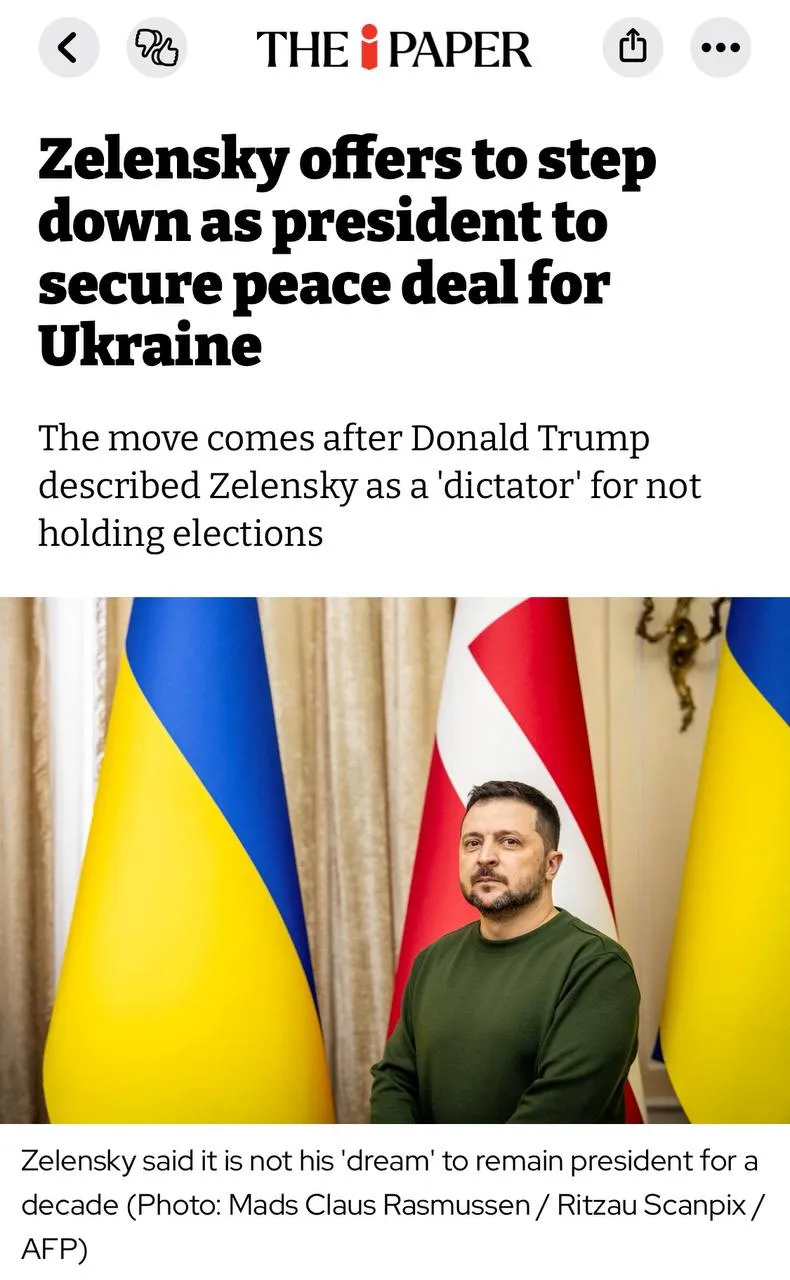
(Video at link.)
All it seemed to take was a few tweets from Musk, and Zelensky’s already drawing up evacuation plans.
Political schemer Arestovich outlined his predictions for Zelensky’s fate: (Video at link.)
But while I use Zelensky’s pronouncement to dress the stage, the main intention was to use this brief report as a battlefield update, given that we haven’t done a proper frontline Sitrep in a while. Part of it had to do with the slow-down on the front, partly due to weather and partly to Russian forces taking a breather. Now there are indications that higher-intensity hostilities are restarting on a number of fronts.
The most unexpected was toward Seversk, where Russian forces of the 7th Separate Motorized Rifle Brigade were said to have finally captured the indomitable fortress of Belgorovka:
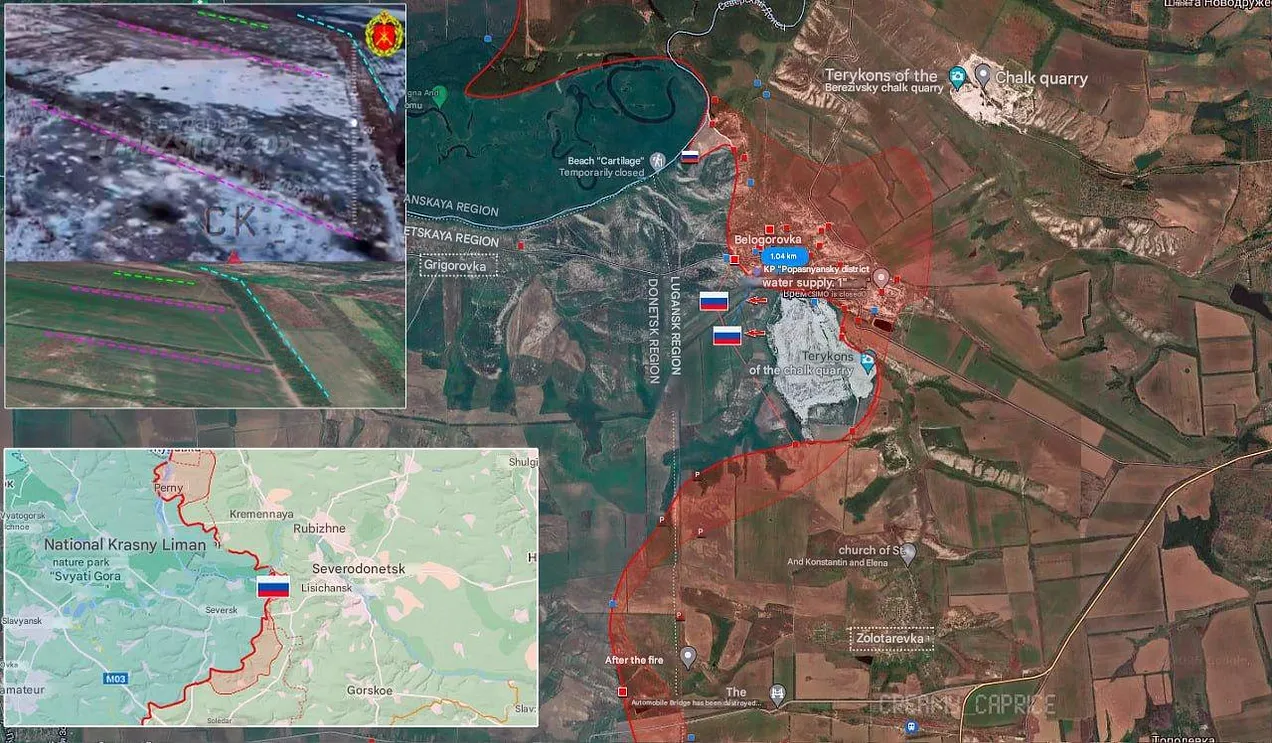
I call it a fortress somewhat tongue-in-cheek, as the area has changed sides many times, and is a rather small but inexplicably intractable section of the front that Russian forces have not been able to decisively break for years. Its seizure now appears to point to the long-expected flagging of Ukrainian defenses all across the frontline.
This is particularly the case given Ukrainian territorial losses elsewhere—in fact this is only the second ‘Belgorovka’ to be captured recently, as another one just northwest near the Terny front was also taken weeks ago. Russian forces, likely of the 4th Guards Tank Army and 144th Motor Rifle Division, had only just crossed the Zherebets river near Terny last month, and now are also advancing in the old Lyman direction:
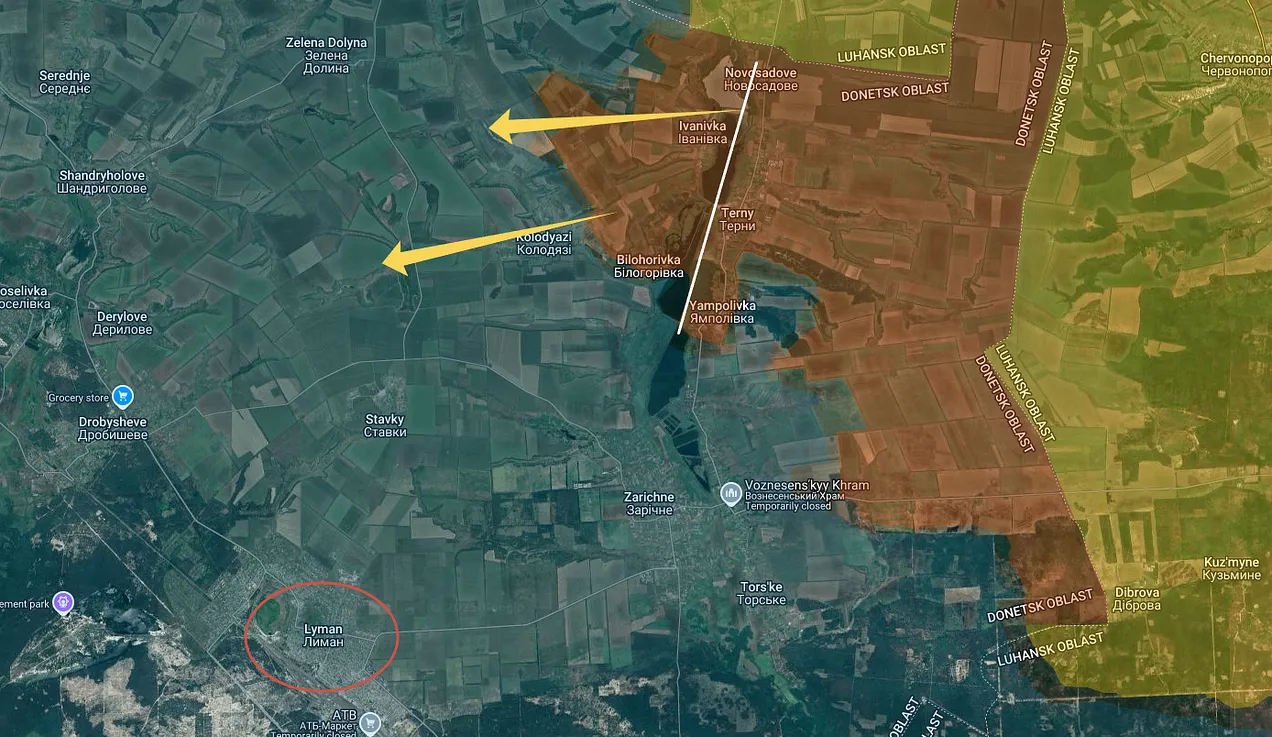
The white line shows the river and reservoirs which Russians had only recently crossed. The objective is to reestablish the old Lyman line as a precursor to assaults on Slavyansk and Kramatorsk.
Meanwhile, in the Kupyansk district, Russian forces have continued expanding the ‘lodgement’ over the Oskil river into a whole new front. Further down on the Chasov Yar front, Suriyak reports modest Russian advances several days ago:
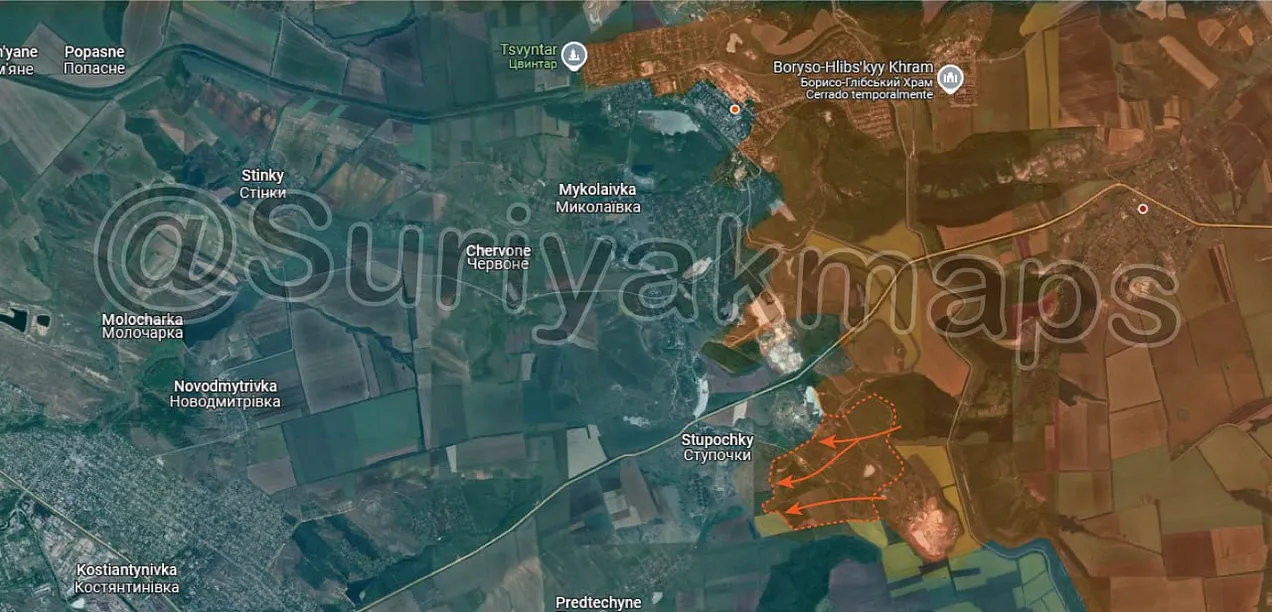
Situation on Chasov Yar front: During the last seven days Russian Army made important advance south of the town taking full control over "Krab" forest area reaching the outskirts of Stupochky village.
On the Pokrovsk front, Russian forces are expanding westward:
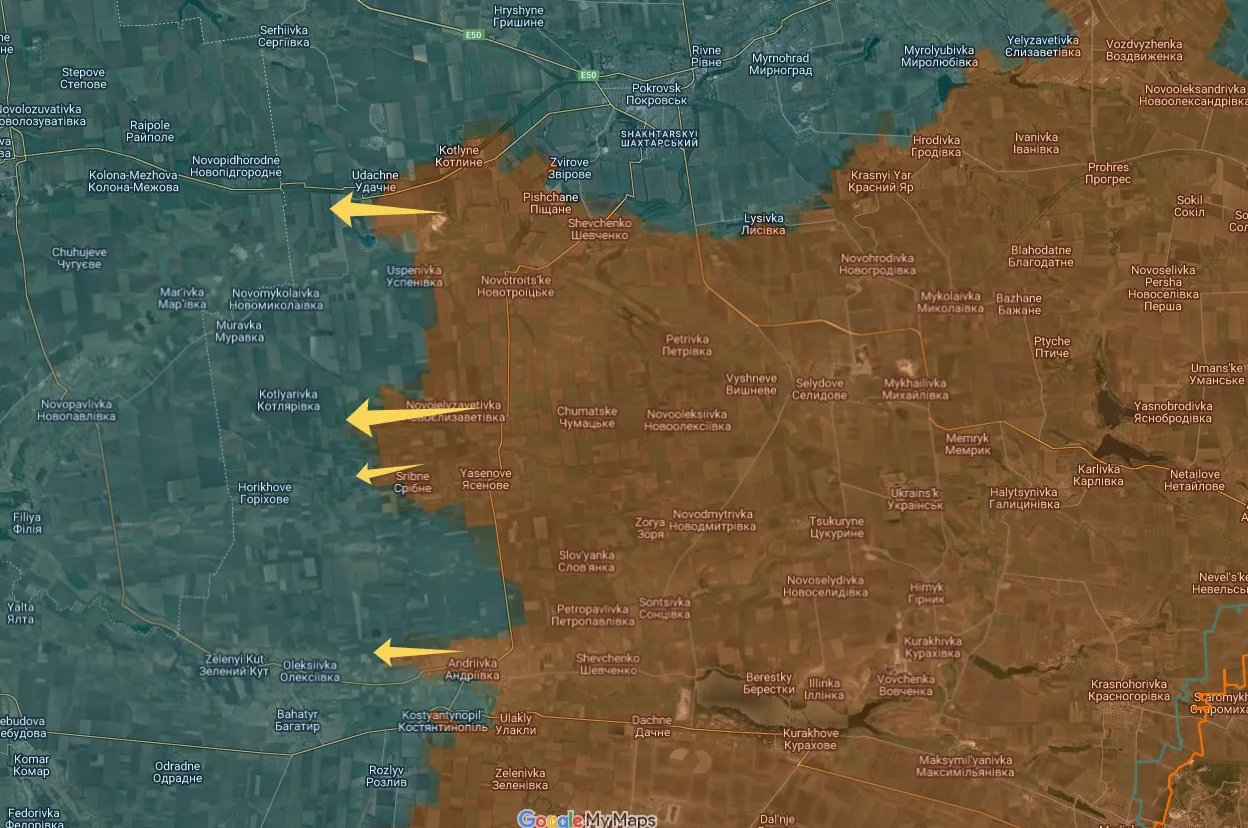
There are other small advances here as well, on the eastern line near Pokrovsk, with Berezovka being captured two days ago. There is no particular strategy, but rather as Ukrainian officers have recently described, Russian forces are continuously probing for weaknesses along the front, and simply making opportunistic advances wherever there’s a gap. Then they consolidate these advances and tactically decide on how to turn them into advantageous mini-cauldrons to further weaken and pressure enemy forces there.
To zoom in closer on the Kurakhove front just south of there, we can see that Russia has collapsed most of the grand Kurakhove cauldron, which is roughly shown by the yellow circle below:
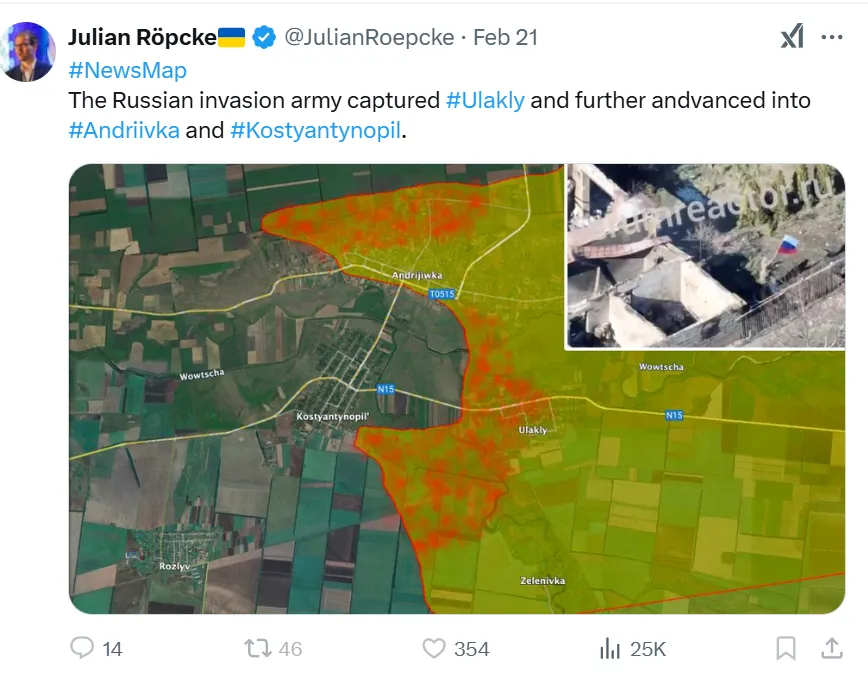
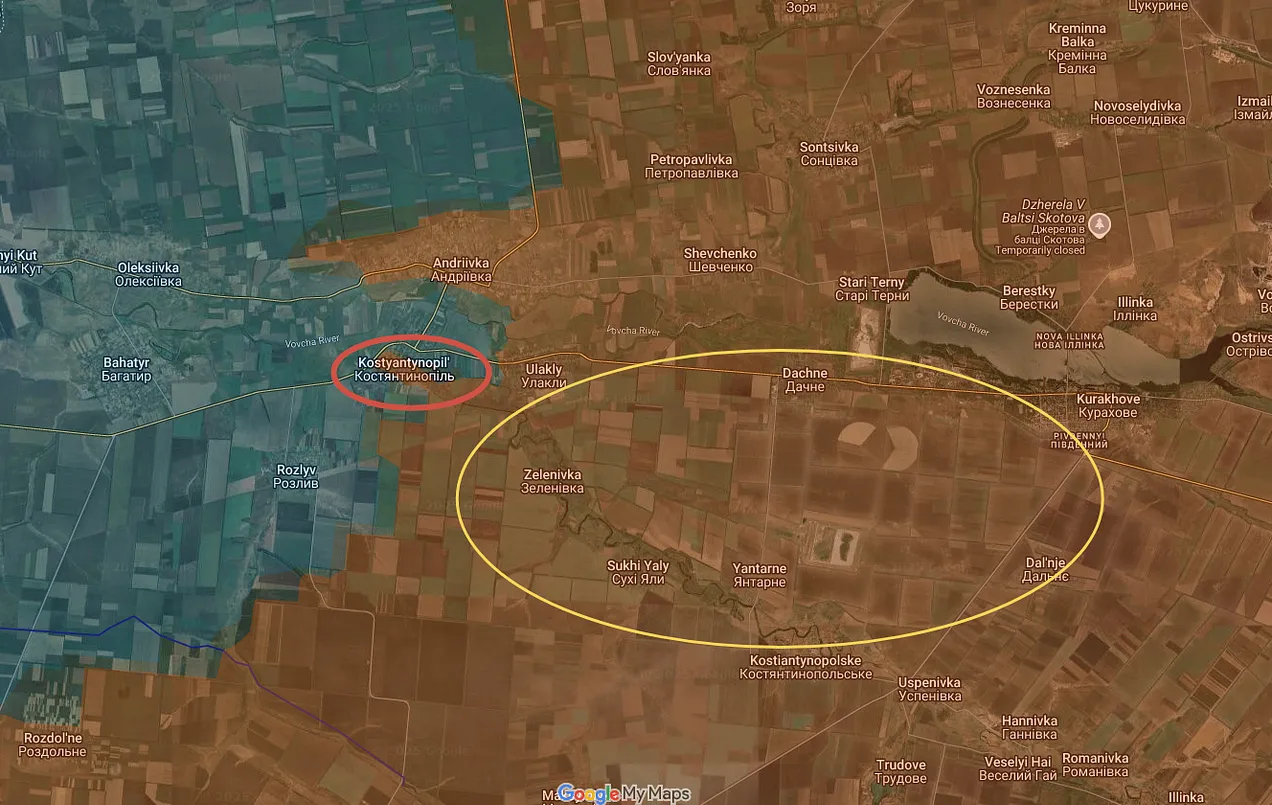
The red circle is where the current advances have been taking place, into Konstantinopl, which has created another mini-cauldron between Andreevka above. For comparison, here’s an image of the region from January, showing how much Russian forces have captured there in several weeks’ time:
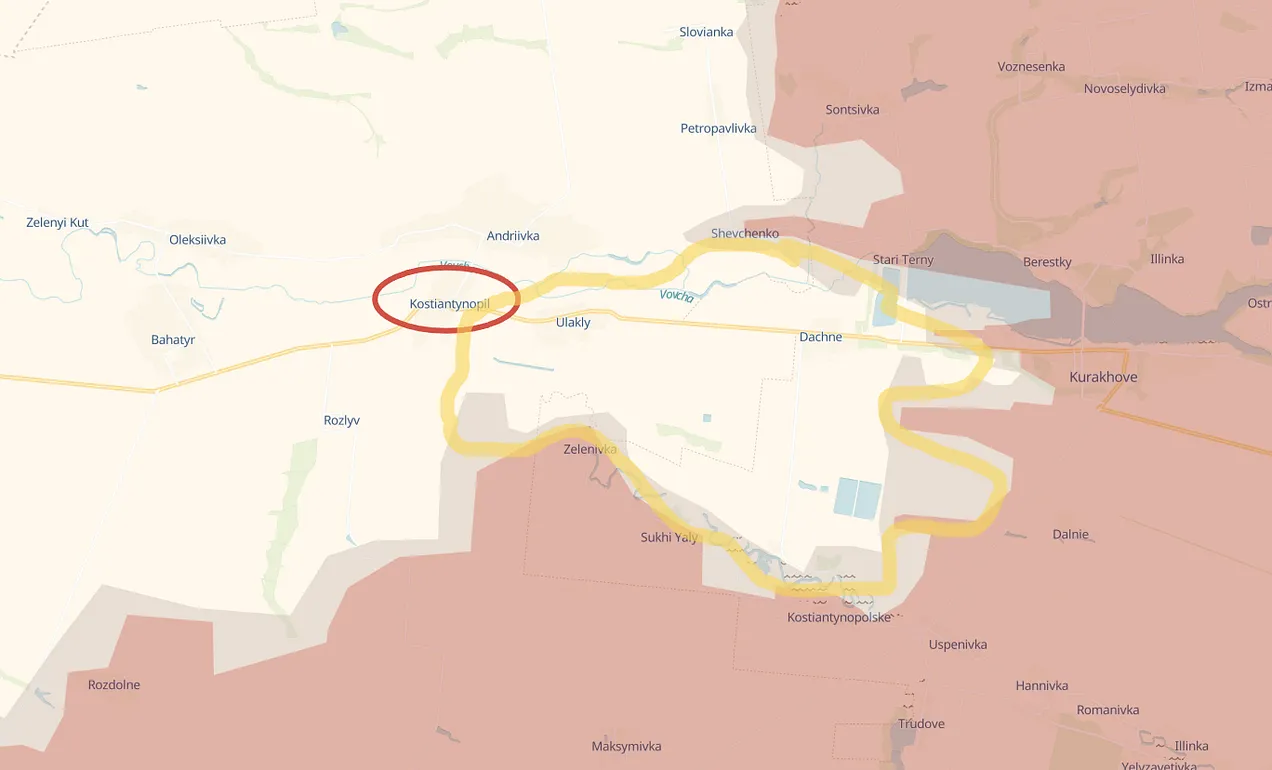
Just a bit southwest from there, Russian forces—after a hiatus—are again advancing on the Velyka Novoselka front. Areas north of Novy Komar were just captured, as well as Novoselka and adjoining areas to its east, all circled in red below:

A close up on Novy Komar, showing Novoocheretuvate and other areas all captured over the past two or three days:
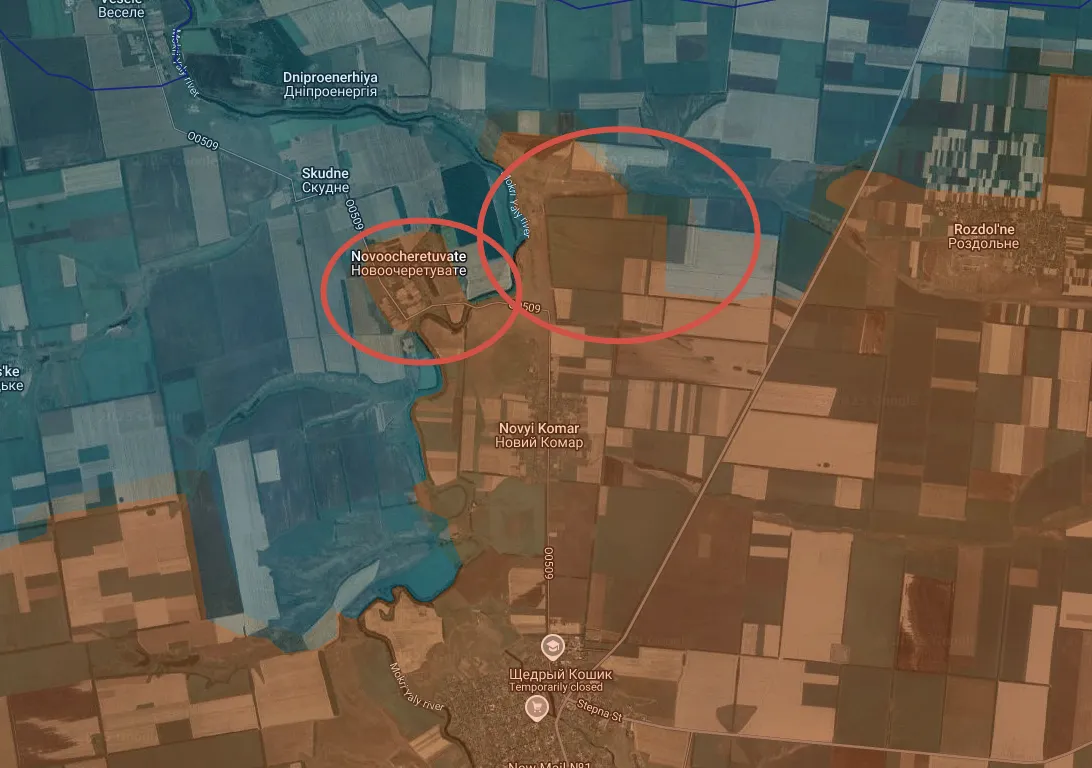
Russian forces are essentially advancing along the Mokry Yaly river there. Not far away on the borders of Dnipropetrovsk region, the AFU is scrambling to erect defensive structures, but there’s only one problem: (Video at link.)
There were a few other minor advances to the west, on the Zaporozhye line near Orekhov, as well as many other much smaller ones in general near Pokrovsk, north of Chasov Yar, on the Svatove front, etc.
But the last most significant advances occurred in Kursk, where Russian forces finally captured Sverdlokovo, and are now expanding a salient eastward out of it:
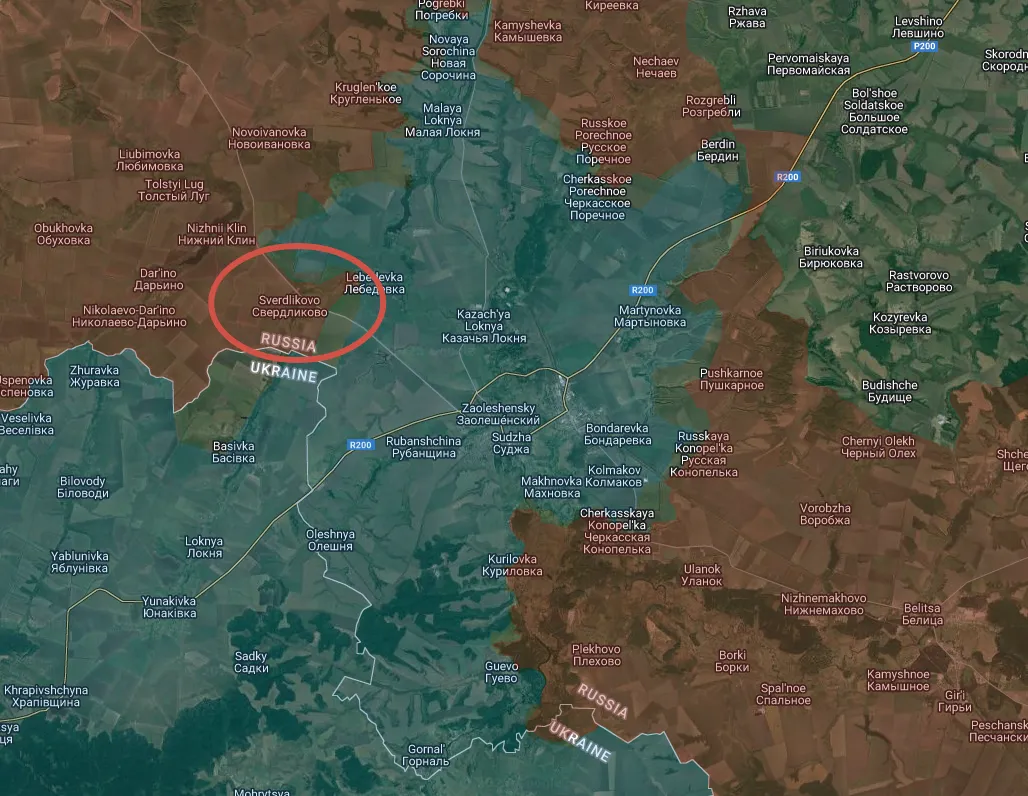
Yes, the Kursk front has now reached its six month anniversary, and many are mystified how or why it’s taking Russia so long to clean it up. The easiest answer is that Ukraine is feeding vast amounts of resources there, including its best remaining equipment—Challengers, Leopards, etc. Just today alone, Swedish CV-90s and Abrams tanks were again spotted there. Meanwhile, F-16s have allegedly been spotted operating in the Sumy region nearby in support of the Kursk troops, while Ukraine’s remaining powerful AD systems have been brought up: today an S-300 was just seen destroyed right on the Kursk border, potentially by a Russian Orion drone: (Video at link.)
The density and concentration of Ukrainian troops in the Kursk region is currently the highest of any front. Drone footage regularly shows entire platoons of troops moving about, as opposed to the odd one or two-man stragglers now so common to see.
But let’s turn to a related topic. Respected Ukrainian ‘reserve officer’ and analyst Tatarigami recently rejected the notion that Ukraine would collapse in six months without Western aid:
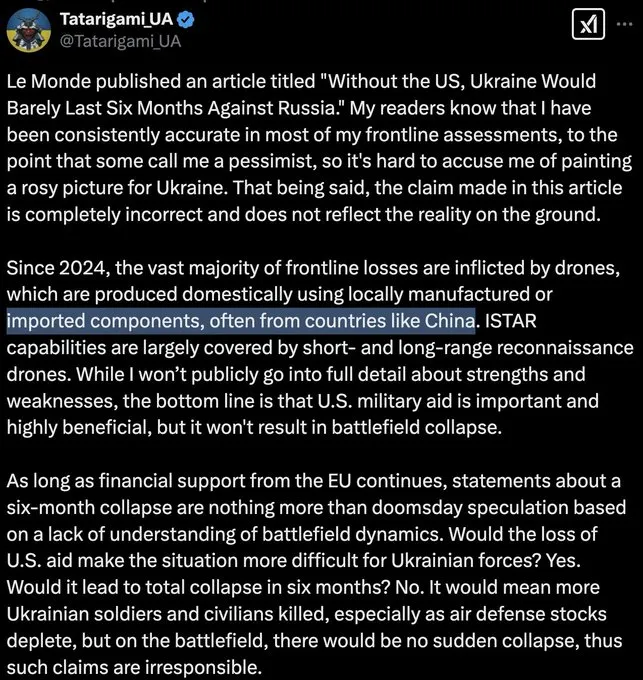
He interestingly keeps repeating the ‘no sudden collapse’ mantra, without ever qualifying the time scale himself. Perhaps instead of six months, he believes the collapse will happen in eight or twelve instead. Either way, it’s silly to argue that the total deprivation of US supplies would not lead to a Ukrainian defeat eventually.
But this all brings up a greater point: he’s deliberately focusing on the military aspect to gin up hopes. But when most people speak of collapse, it’s not merely from the military dimension, but as a totality of the Ukrainian state. I have stated multiple times myself that it’s more likely that Ukraine will ultimately lose via internal revolution leading to some kind of capitulation, rather than military defeat. The cutting off of US aid has far greater dimensions than just military: it will result in a lot of internal political and moral turmoil, which will greatly exacerbate the potentialities for a regime collapse.
Just look at what happened now: the mere suggestion of Trump cutting off supplies and leaning on Zelensky has led to the unprecedented talk of Zelensky resigning, which has already brought regime and state collapse one step closer to fruition. Now imagine this six months down the line or so, if events continue along the current trajectory.
If the war was fought on a purely military scale, with no outside factors involved, then certainly the current pace would be on course for several more years of fighting. But things don’t happen in a vacuum like that: every political exigency affects the military, social, moral, and economic spheres. Ukraine is now in political crisis, and without the previous “optimism” of staunch US support, societal support could quickly collapse, leading to a crisis spiral that will have repercussions on everything.
The fact is, war itself is fought in many spheres and domains. It was Gerasimov, according to the West, who underlined this in his infamous ‘doctrine’ about new generation warfare, where the military sphere is just one small—and sometimes subordinate—aspect. As such, Russia doesn’t need to defeat Ukraine “purely” on the battlefield—it is already defeating the combined West on the hybrid battlefield, which includes all possible intersecting spheres and dimensions.
This is why it’s foolish to bean-count armor losses or territorial shifts by the square meter, using sterile metrics as ‘proof’ that Russia is advancing too slowly to win any time soon. Russia’s real ‘advances’ are not so easily quantifiable and are clearly paying massive dividends considering the enemy leader has literally just floated resignation. Of course, that’s not to say the war would end with Zelensky’s departure; but it could certainly enter another terminal phase favoring Russia.
That said, as the politico-social aspects take a nosedive in Ukraine, Russia is set to turn the screws by applying even more military pressure to accelerate things. This spring we can expect renewed offensives on many different fronts. In accordance with this, there continue to be persistent rumors that Russian forces are gearing up to storm the Dnieper river in order to seize Kherson. New footage of the marines on the Dnieper front practicing water crossing continues to emerge: (Video at link.)
That being said, for all we know these are exercises to seize certain territories in the case of a total Ukrainian governmental and military collapse, rather than during real war time. Russian leadership likely knows that the French and British are looking to insert troops to stave off total Russian conquest of Ukraine, and so Russian troops may be hoping to reach certain key cities before any NATO contingents get there. There also continue to be new rumors that the French are eyeing Odessa, as always.
France is preparing to "occupy" the Odessa region under the guise of introducing peacekeepers. Zelensky has already promised Macron.
The French contingent is present in Odessa, but this is not officially recognized.
As is the presence of the British Navy's naval special forces.
Today the Special Military Operation hits its three year anniversary, having started with this famous moment as Russian columns barreled through the Armyansk checkpoint on the Crimean-Ukraine border:
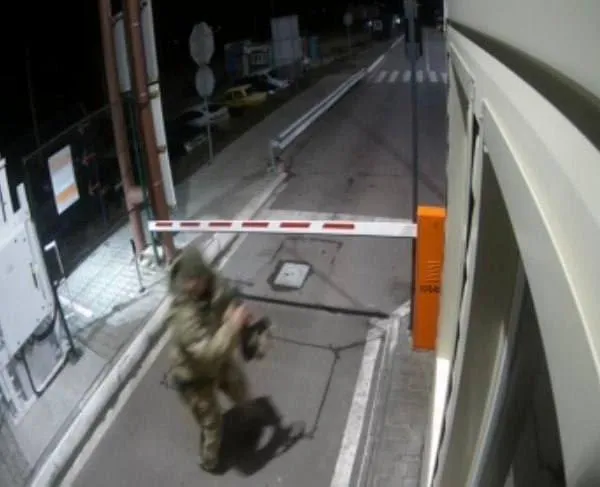
A surprised Ukrainian guard jumps out of the way of incoming Russian columns at the Armyansk checkpoint.
As wars go, this one is yet young. Vietnam didn’t get truly under way until ‘65 and US troops left in ‘73. The biggest surprise of the war in most people’s eyes was that the ‘invincible’ Russian military underperformed, while the ‘laughable’ Russian economy surprised everyone by overperforming and virtually buoying the whole thing up. Of course, now things are meeting somewhere in the middle—but it’s an interesting dichotomy nonetheless. Now that major Western corporations are edging toward returning to Russia, several Russian officials have declared that these companies should not be allowed back so easily, because the vacuum they left has been good for Russia, vis-a-vis localization, import substitution, and the like.
Just like in the case of the above perplexing dichotomy, Russia has always been, and continues to be, an enigma. Virtually from every angle, Russia can be analyzed in seemingly contradictory ways: it’s a country that always seems somehow on the brink of disaster, yet surprisingly resilient. Recently Western ‘experts’ have used the population ‘crisis’ to highlight Russia’s major birth decline—a point which ignores that the SMO has gained Russia millions of new citizens—and quality ones at that, unlike what’s being imported in the West. By the time the SMO is done, the Russian population may have gained a net positive of upwards of 10-15 million people, if they seize Kharkov, Odessa, Nikolayev, Dnipro, Zaporozhye, etc. This is just one example of many.
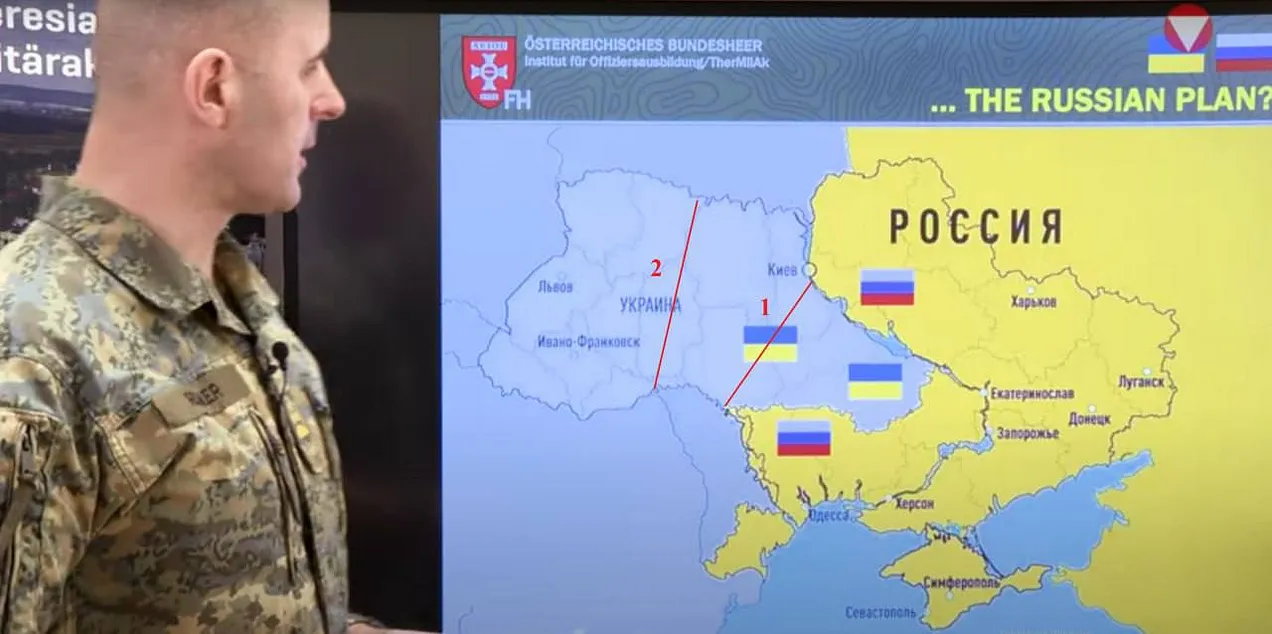
Clip from Colonel Reisner’s latest break down.
Even now, we see the paradoxical reports on the ground: Russia has both lost millions of troops, yet is gaining dozens of new divisions and entire field armies. Russia is using horses and donkeys, yet inexorably advancing in every direction. No greater example of these schizophrenic Western hallucinations was seen than this viral tweet from last week:
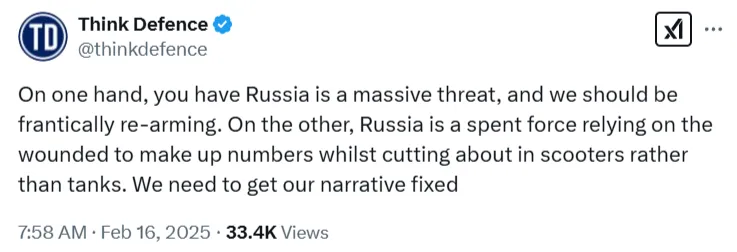
We all know the famous apothegm attributed to Churchill and others:
"Russia is never as strong as she looks, nor as weak as she seems."
In many ways the quote is a reflection more of the West’s own confused self-delusions when it comes to Russia. Russia remains a ‘riddle wrapped in an enigma’ precisely for the reason that the West’s totally captured intelligence apparatuses make certain to always confound, obscure, and obfuscate anything and everything related to Russia, such that a clear picture of it can never be grasped. It serves the generational, internationalist elites to always keep Russia shrouded in a thick perpetual haze, because true understanding is the flower of friendship and good relations, and the generational cabal of perfidious Albion simply cannot allow that. Why, you ask? Because it’s a small pirate rock adrift at sea, with no resources of its own. To allow the Eastern Monstrosity to be ‘understood’, and to have friendly relations with European neighbors, would be to yield dominion of the Western world to the great ‘Other’, with its inexhaustible resource and riches.
For now, the battles will continue raging for much smaller stakes than that, as we move into the next phase. The knives and hatchets have come out for Zelensky, and it will be interesting to see where things go from here.
(Video at link.)
https://simplicius76.substack.com/p/pre ... ow-reality
********
Yes, Ukraine Started the War
February 23, 2025
Donald Trump has been flayed alive by Western media and leaders for saying Ukraine started the war. Here are facts, not myths, says Joe Lauria.

Protesters clash with police in Kiev, Ukraine, February 2014. (Mstyslav Chernov, Wikimedia Commons, CC BY-SA 3.0)
On Feb 20, 2014, Viktor Yanukovych, who was elected president of Ukraine in 2010 in a popular vote certified by the OSCE, was violently overthrown.
Yanukovych’s base in the Russian-speaking parts of Eastern and Southern Ukraine refused to recognize the unconstitutional government that took over, defending their democratic rights.
Majority ethnic-Russian Crimea, a huge base of Yanukovych’s support, voted little more than a month later, on March 16, 2014, to leave Ukraine and rejoin Russia. The Ukrainian government had also declared that it would not extend beyond 2017 Russia’s lease on a Black Sea naval base in Sevastopol, Crimea.
Street violence broke out in other parts of Ukraine. Five days after extreme right-wing Ukrainian gangs burned alive 48 Russian speakers in a trades union building in Odessa, two of the Eastern provinces declared independence from Ukraine and took over government buildings.
With U.S. backing, the unconstitutional government on April 16, 2014 launched a military attack against those two provinces in the Donbass region.
This is how Ukraine stated the war and the date they did it on.
Trump didn’t mention the instrumental part the U.S. played in Yanukoych’s ouster and Kiev’s subsequent war on Donbass.
US Role in Starting the War
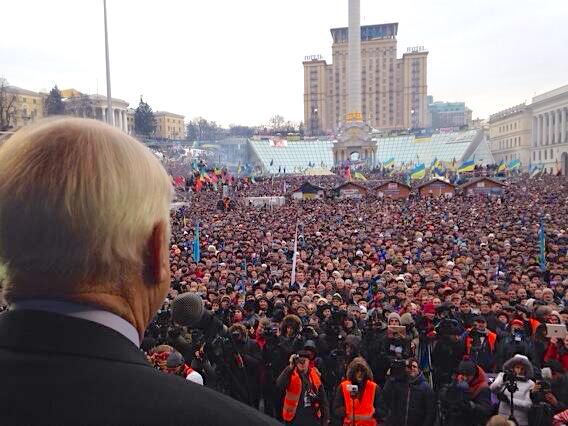
John McCain addressing crowd in Kiev, Dec. 15, 2013. (U.S. Senate/Office of Chris Murphy/Wikimedia Commons)
Think of an encampment of protesters in Lafayette Park, some of whom are violent. They are calling for the ouster of the U.S. president from the White House across the street.
Two senior Russian lawmakers then show up in the park. They appear with protest leaders and address the crowd, encouraging them, telling them Russia is with them.
Then the Russian deputy foreign minister in charge of North American affairs appears in Lafayette Park handing out food to the encamped demonstrators.
Later the minister is caught on an open telephone line discussing with the Russian ambassador to the U.S. the composition of the new American government once the president is overthrown. This minister had also made a speech saying Russia spent $5 billion to bring democracy to the United States.
The elected American president is then overthrown violently and flees the country. Russia installs the government it has selected. California rejects the Russian-installed regime and says it is breaking away from the United States. The new coup government then launches a war against California.
If this actually happened in Washington, do you think anyone in the U.S. would say that Russia had anything to do with overthrowing the U.S. government? Or would they have just said he was ousted by “popular demonstrations?”
But this is precisely what happened in Ukraine in 2014. The role of the legislators was played in real life by Senators John McCain and Chris Murphy. The deputy foreign minister was played by Victoria Nuland, the then U.S. assistant secretary of state for Eurasian affairs.
Obama Tries to Contain the War
Russia came to Donbass’ defense with arms, equipment, ammunition and the quasi-independent Wagner mercenaries. To cover up Kiev’s aggression, and to justify it, Western governments and their media falsely called Moscow’s help to ethnic Russians an “invasion.”
After the illegitimate government began its attack on the breakaway Russian regions, President Barack Obama tried to limit its escalation. The New York Times reported on March 10, 2015:
“The president has signaled privately that despite all the pressure, he remains reluctant to send arms. In part, he has told aides and visitors that arming the Ukrainians would encourage the notion that they could actually defeat the far more powerful Russians, and so it would potentially draw a more forceful response from Moscow.
Mr. Obama continues to pose questions indicating his doubts. ‘O.K., what happens if we send in equipment — do we have to send in trainers?’ said one person paraphrasing the discussion on the condition of anonymity. ‘What if it ends up in the hands of thugs? What if Putin escalates?’”
First, Obama is talking about a war that was ongoing, that had started the year before, not seven years later. Second, Obama is keenly aware that U.S. lethal aid to Ukraine, while fighting a civil war against Russian-speakers, would provoke Russia.
And third, Obama admits here what Western orthodoxy now denies, (but which was widely reported in the mainstream at the time), namely that “thugs” were a big problem in Ukraine. By thugs Obama clearly meant extreme right-wing and neo-Nazi groups fighting for Ukraine. [See: On the Influence of Neo-Nazism in Ukraine]
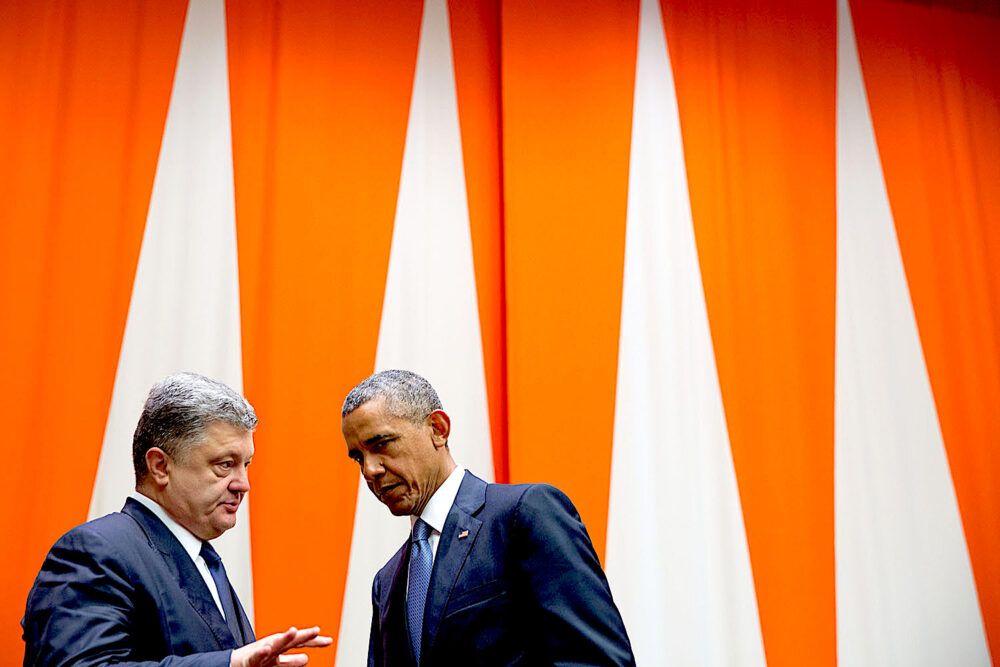
September 2015: President Barack Obama, right, in a pull-aside conversation with Ukraine’s President Petro Poroshenko outside the U.N. in New York. (White House/Pete Souza)
Trump Gives In to Pressure
During the 2016 Republican Convention a plank in the Republican party platform was found by Democrats that said no lethal aid to Ukraine. Under the deranged influence of Russiagate, this was trumpeted as evidence of Trump’s collusion with Russia, even though it was only the continuation of Obama’s exact policy.
Trying to escape the pressure of Russiagate, Trump listened to his treacherous advisers and armed the Ukrainians, greatly exacerbating the war and provoking the Russians, as Obama feared.
Trump said last Tuesday that Ukraine had many chances to make a deal with Russia. To try to end the war, Russia backed the Minsk accords, which grew out of a Kremlin meeting with German Chancellor Angela Merkel in May 2015. The accords, which were endorsed by the U.N. Security Council with U.S. assent, would have left the breakaway eastern provinces inside Ukraine with autonomy.
However, France, Germany and Ukraine, including three years under Zelensky, blocked its implementation. Merkel, former French President Francois Hollande and Ukrainian President Petro Poroshenko all admitted they strung Russia along in buy time for NATO to arm and train Ukraine.
This is what Trump apparently meant when he said Zelensky had three years to do a deal, or rather to implement a deal already made.
With signs of a renewed Ukrainian offensive against Donbass, Russia presented NATO and the U.S. two treaty proposals in December 2021. They called for a new security architecture in Europe, namely the withdrawal of NATO troops from former Warsaw Pact countries and U.S. missiles from Poland and Romania minutes away from Moscow.
Trump keeps repeating that the Russian intervention would never have happened had he been president. Perhaps he would have negotiated these treaties.A Daily Mail story last week said Trump is considering withdrawing U.S. troops from the Baltics, part of what Russia wants in a new security arrangement in Europe. It’s part of what Russia has been arguing for decades.
Moscow told the Biden administration that if the treaties were rejected, Moscow could resort to “technical/military means” in Ukraine.
Fully understanding that this meant a new, more deadly phase of the war, Biden rejected the treaties, provoking Russia’s direct intervention in the civil war. Biden needed this to happen to become the “start” of the war — as if history began on Feb. 24, 2022.
Biden and his defense secretary made plain the U.S. aim was to “weaken” and to overthrow the Putin government and return to the dominance the U.S. enjoyed over Russia in the 1990s.
To do this, Biden needed Russia’s invasion in order to launch an information, economic and ground proxy war against Russia. Three years later, the West has lost all three and is still lying about when it all began.
https://consortiumnews.com/2025/02/23/y ... d-the-war/
******
Ukraine and the U.S. mineral deal
Sonja van den Ende
February 24, 2025
New elections in Ukraine could pave the way for a government that prioritizes the interests of its people. But that is probably a utopia in the current circumstances.
Ukraine is one of the world’s leading countries in terms of mineral wealth. Despite covering only 0.4% of the Earth’s surface (excluding the Donbass region), it holds approximately 5% of the world’s mineral resources. Ukraine ranks among the top 10 global producers of various raw materials, including titanium, ball clays, Fe-Mn & Fe-Si-Mn alloys, and gallium. Additionally, it is rich in lithium, graphite, and magnesium.
But where exactly are these minerals located? Primarily in the former eastern Ukraine, now part of Russia. Lithium, in particular, is concentrated in the Donbass region. Other critical mineral resources, accounting for about 70% of Ukraine’s total, are found in the Donetsk, Dnipropetrovsk, and Lugansk regions—areas currently under Russian control. Russia has seized at least two significant lithium deposits: the Shevchenkovskoye deposit in Donetsk and the Kruta Balka complex ore deposit in the Berdyansk area. Meanwhile, lithium ore deposits in the Kirovograd region remain under Ukrainian (or Western) control.
Ukraine’s iron ore production is another key asset. The country’s main iron ore-producing region, a narrow strip approximately 100 km long and 2-7 km wide, stretches through the western Dnipropetrovsk Oblast from Zhovti Vody in the north to Inhulets in the south, covering about 300 km². The city of Kryvyi Rih, the region’s industrial hub, remains under Ukrainian control. In 2005, the infamous Metinvest invested and privatized Kryvorizhstal. Metinvest BV, should ring bells again, it is the BV (fake BV). A “besloten vennootschap” (BV) or “société à responsabilité limitée” is the Dutch and Belgian version of a private limited liability company. The company is owned by shareholders; the company’s shares are privately registered and not freely transferable. Metinvest launders its money in the Netherlands, a subject I have written about many times, Azovstal in Mariupol was also owned by Metinvest, until Russia liberated it in 2022.
The Trump administration, including figures like Lindsey Graham, has sought to secure access to these minerals through a deal with the Western-backed Ukrainian government. The U.S. interest in controlling rare and critical minerals stems from its competition with China, which dominates the global supply chain for these resources. This push aligns with the “America First” policy, reflecting both economic pressures and the administration’s expansionist ambitions.
At first glance, this seems paradoxical. While Trump has championed fossil fuel expansion and dismissed climate concerns, the renewable energy sector—which relies heavily on minerals like lithium—remains a priority for the U.S. These minerals are also essential for consumer electronics, military and navigation equipment, and, crucially, data centers for Artificial Intelligence (AI). Trump, alongside Elon Musk, has grandly announced the Stargate project to expand AI capabilities in the U.S., requiring vast supplies of copper, silicon, palladium, and rare earth metals—many of which are found in Ukraine.
Recently, White House National Security Advisor Mike Waltz urged Ukrainian President Zelensky (who is not legitimate) to negotiate a deal granting the U.S. access to Ukraine’s critical minerals. Waltz proposed a 50-50 split, citing the substantial aid the U.S. has provided to Ukraine during its conflict with Russia. However, Zelensky rejected the offer. Waltz expressed frustration with Zelensky’s “unacceptable” insults toward Trump, raising questions about whether the U.S. administration’s primary concern is peace or securing mineral deals.
Public exchanges between the two sides have grown increasingly contentious, with threats and negotiations playing out in the open. Elon Musk, a key figure in the Starlink program and a supporter of the Stargate project, has reportedly threatened to cut off Ukraine’s access to Starlink satellite internet if Kiev refuses to agree to the mineral deal. According to U.S. media, a deal is likely in the works, with Keith Kellogg, the U.S. envoy to Ukraine, mediating between Washington and Kiev.
But is Keith Kellog the right man? Probably for Zelensky, as Tass recently reported. His daughter, Meaghan Mobbs, heads the R.T. Weatherman Foundation, which provides aid to Ukraine. The foundation has been active in the Donbass since the start of the special operation in February 2022, evacuating wounded American mercenaries to the U.S. Armed Forces Special Medical Center in Landstuhl, Germany, and repatriating the bodies of those killed in combat. This underscores the presence of foreign fighters in the region, a fact often downplayed in Western narratives.
Landstuhl, the largest U.S. military hospital in Europe, is a symbol of America’s extensive military presence in Germany—a presence Trump has vowed to reduce. However, the new U.S. administration has yet to act on this promise, despite its critical stance toward Europe. While the U.S. bears significant responsibility for the current conflict, there has been no discussion of withdrawing troops from Germany or other parts of Europe—a move that would align with the emerging multipolar world order.
Regarding Ukraine’s minerals, a fair and sustainable solution is essential. New elections in Ukraine could pave the way for a government that prioritizes the interests of its people, ensuring that the proceeds from mineral deals are used to rebuild the country free from globalist influence. But that is probably a utopia in the current circumstances.
https://strategic-culture.su/news/2025/ ... eral-deal/
******
"Kremlin Narratives"
February 25, 7:35

Putin said that:
1. Russia is not against preserving the statehood of Ukraine, the main thing is that no threat to Russia emanates from its territory.
2. Russia is not against the partnership participation of other countries in the development of rare earth metals, of which Russia has many times more than Ukraine. A thick hint of level 80.
3. Zelensky will lose in any relatively democratic elections in Ukraine. His rating is half that of Zaluzhny. Zelensky's departure plays into the hands of Ukraine itself.
4. The current EU leaders cannot jump off the topic of supporting Zelensky without losing face.
Trump can afford to say whatever he wants. Europe can sit at home with its demands.
5. The EU can ask for participation in negotiations on Ukraine, but cannot demand it. Participation of the BRICS countries in the negotiations is also desirable.
6. Russia is interested in achieving peace in Ukraine as soon as possible.
7. Russia thinks it would be a good idea to cut US and Russian defense spending by 50% (although 50% of Russian defense spending and 50% of US defense spending are, of course, two very different things).
8. The "Peace Group" on Ukraine will soon meet in New York. China will be there.
9. Russia is not against joint aluminum production with the US in Siberia. Russia is ready to sell aluminum to the American market in the amount of 2 million tons.
10. Companies from the US and Russia are already discussing the development of joint projects.
In general, Putin has given the go-ahead for the appointment of Zaluzhny as a new puppet and is ready to consider resuming economic ties with the US.
* * *
Macron said that the EU spent $138 billion on the war in Ukraine.
At the same time, after talking with Trump, he said that frozen Russian assets cannot be taken away in any way, since this would be a violation of international law. In general, they will only steal interest from frozen funds.
Macron also said that "now there is a good reason to resume relations with Putin."
"A compelling reason to renew relations with Putin" - a 5-letter word.
Macron also approved the transfer of Ukrainian mineral resources to the United States. This is what communication with Trump does. Changed his tune in mid-air.
* * *
Boris Johnson called on Ukraine not to repay the US debts on the mineral deal and called Trump's statements "Kremlin narratives".
In 2022, Johnson's advice "Let's fight" led to monstrous consequences for Ukraine.
One can only imagine what the refusal to repay the US debt may lead to in 2025.
At the same time, Macron spoke "for a quick peace in Ukraine". After a visit to Trump, he quickly changed his tune and wagged his tail.
* * *
There is a strong feeling that in fact some agreements on the future of Ukraine and the end of the war have already been reached within the framework of unofficial diplomacy and we are rather observing a stage of consistent implementation of the agreements already reached, stretched out in time, where the parties are following the agreed points.
The current statements and steps of Russia and the US are too synchronous and most likely foreshadow the end of the war in 2025 (which the US and Russia openly declare), although of course the globalists will try to drag out the war until 2026 and beyond, which is what the European Union is now trying to do, trying to increase the supply of weapons and ammunition.
https://colonelcassad.livejournal.com/9690522.html
Macron is being told about dictatorship
February 25, 11:12

Your face when they explain to you that Putin is not a dictator.
(Video at link.)
After his visit to Trump, Macron urgently declared that:
1. Russian money cannot be confiscated.
2. Peace is urgently needed in Ukraine.
3. Negotiations with Putin are urgently needed.
4. Ukraine must repay its debt to the United States.
At night, Russia, the United States, and China voted together in the UN Security Council FOR the UN Security Council resolution without condemning Russia.
A little earlier, the United States, together with Russia, voted against the UN General Assembly resolution condemning Russia.
https://colonelcassad.livejournal.com/9690877.html
Google Translator




